News Posts List
Latest News from the Marine Mammal Rescue Team, January-July 2015
01/01/2015
July 29, 2015
"BAR" weanling harbor seal
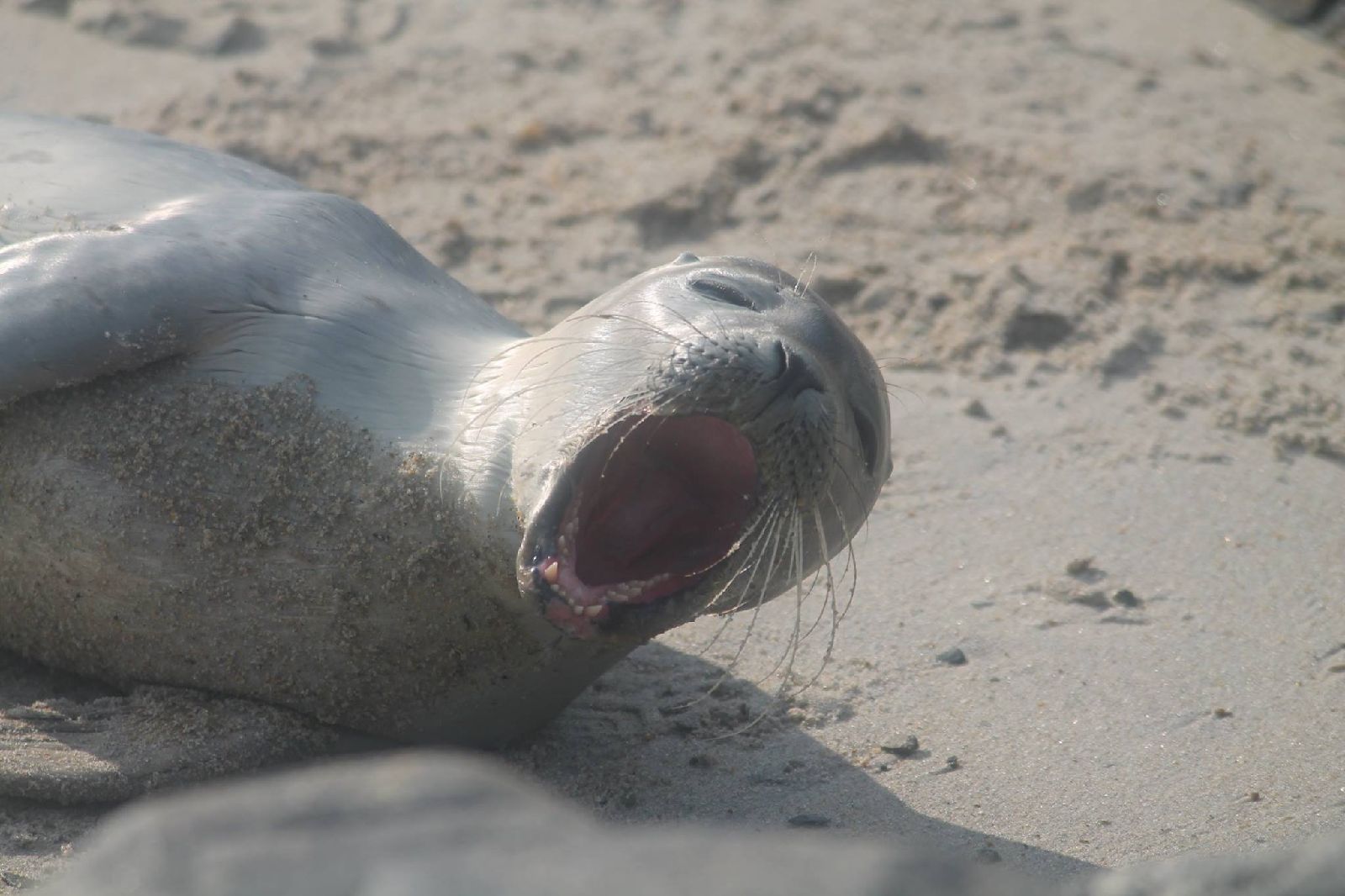 |
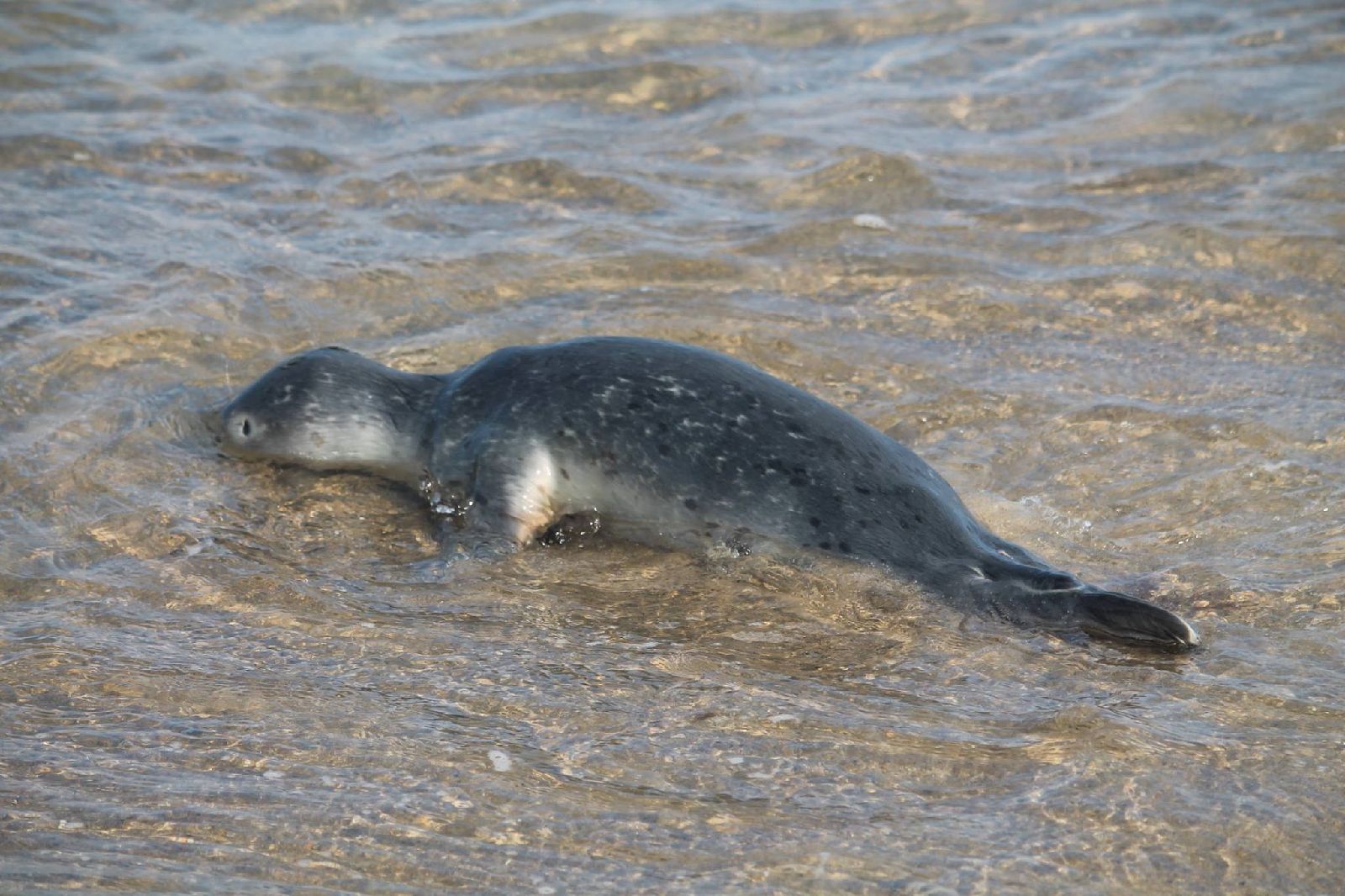 |
Today, we responded to this weanling male harbor seal on the beach in Hampton, near the bridge. He was "BAR" (bright, alert, and responsive) which we love to see in these young seals! But he did have a small wound on his mouth, and many small bumps/abrasions on his abdomen. You can see the abrasion/wound on his lower jaw in this photo. The seal took a rest (yawn!) on the beach before heading back out to the ocean when the tide covers the spot where he hauled out.
July 25, 2015
Camomile brought to rehab
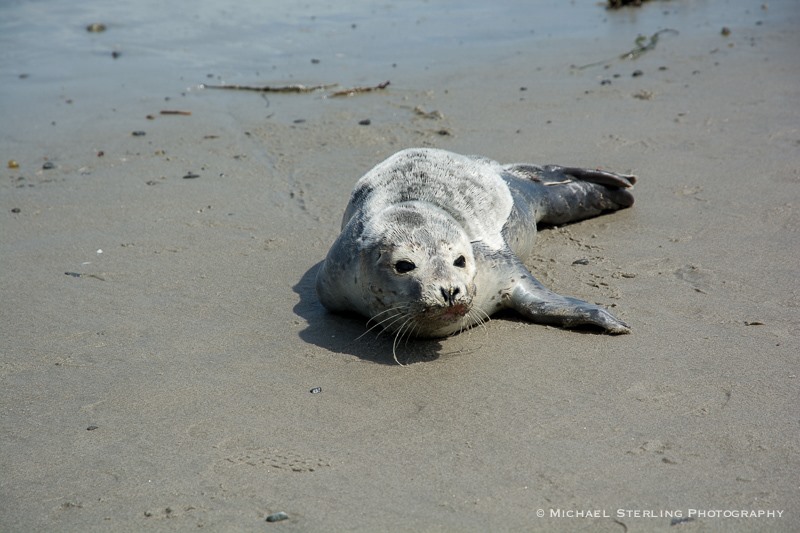 |
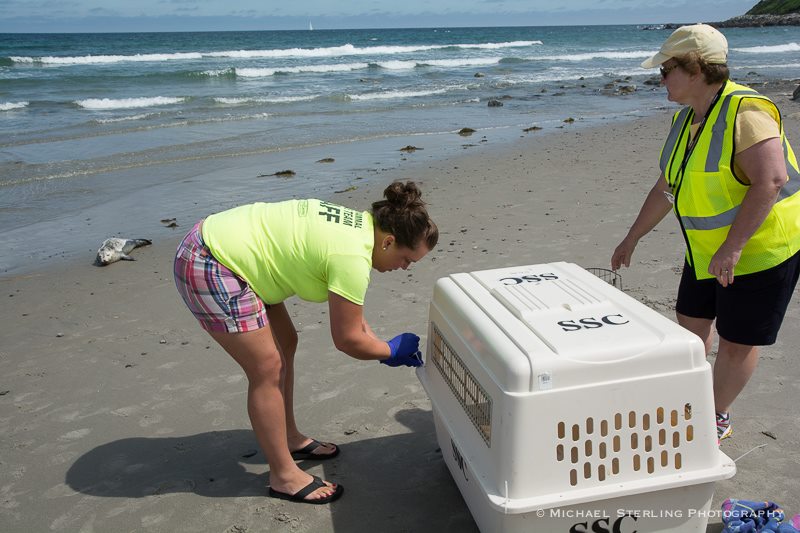 |
On July 25th, a weanling harbor seal (meaning she was born this May-June and is no longer dependent on her mom) hauled out at North Beach in Hampton, just in time for the beach to start getting busy for the day. With many people coming down to enjoy the beach, the seal didn't stay long before returning to the water. But because she was injured, she wasn't able to stay in the water long and returned a short time later, even though it was getting busy. She has a few abrasions/injuries to her face and mouth and puncture wounds on her tail, which may be due to a canine/dog. She is also not using her right front flipper and it's very swollen.
As a result of all of these things, we decided that she needed to be removed from the beach and taken into rehab. She was removed from the beach around 2pm and was transported to National Marine Life Center in Buzzards Bay, MA for rehab and has been given the name Chamomile (NMLC's naming theme this year is herbs/spices). The next few days are critical, but our colleagues at NMLC will do their best to nurse her back to health. We will post updates as we have them.
July 3, 2015
Plum Island weanling harbor seal
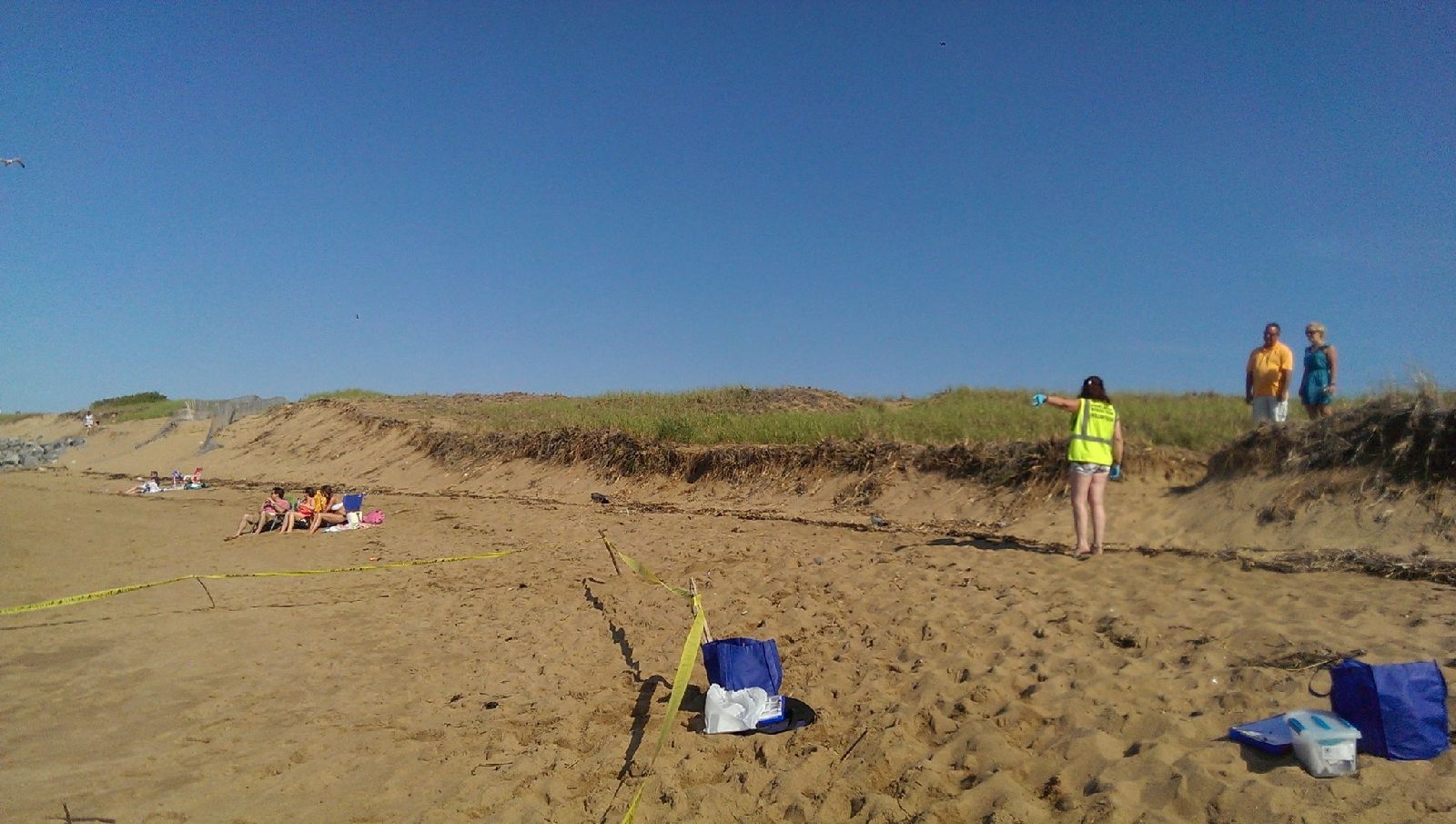 |
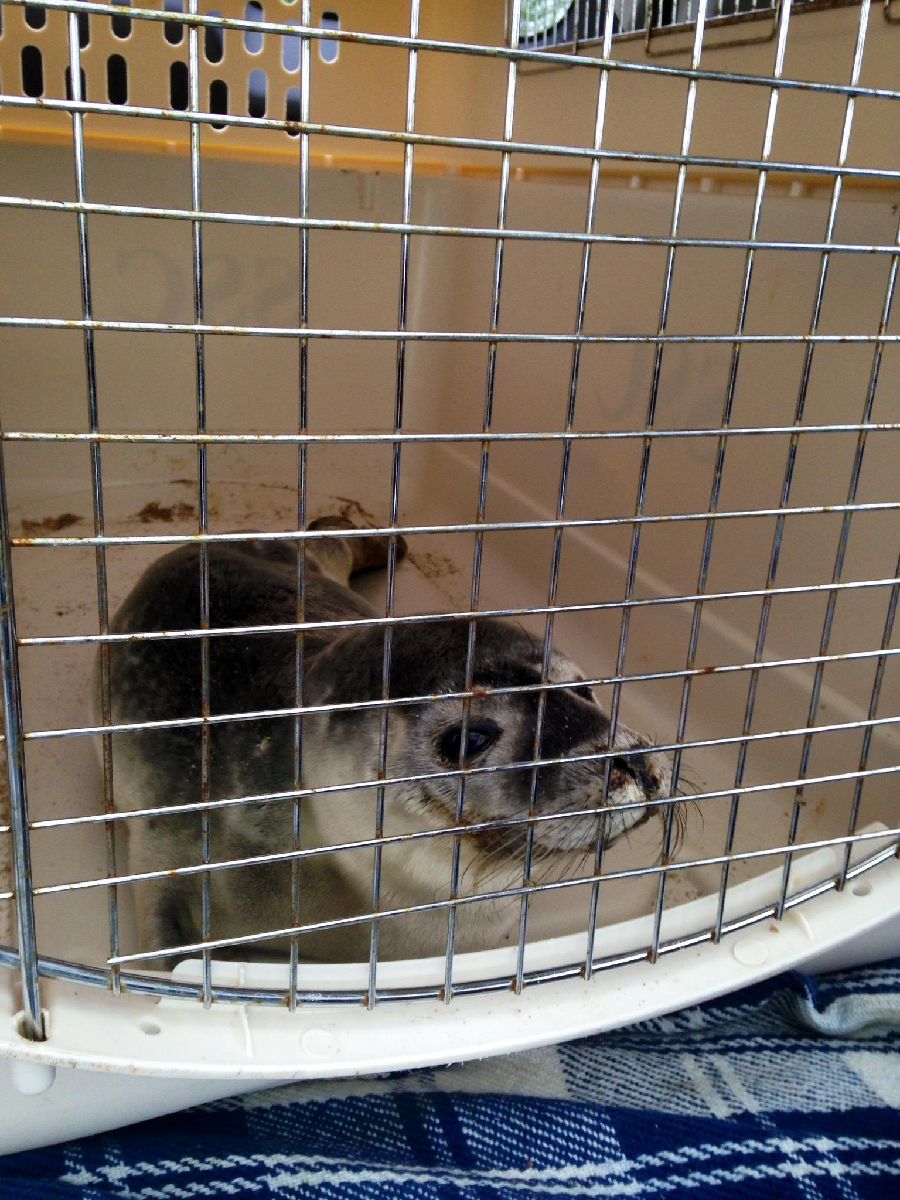 |
On Friday July 3rd we received a few reports about another weanling harbor seal. This one was on Plum Island near the south jetty. Upon arriving at the scene, our field responder was told that the seal had swam off. But a couple hours later the seal returned so we went back down there. Again, because this animal looked to be okay overall, despite being thin, and she had gone into the water a couple of times. So again we decided to monitor her for the day to see what the following morning brought. She was still there this morning (4th of July) and her health was about the same. We decided to transport her to rehab. She was removed from the beach and taken to New England Aquarium's animal care facility where she received some triage assistance with fluids and a blood check, before being transferred down to National Marine Life Center. The next 24 hours are the most critical to see how she does and even after that, the next few days will be critical as well. But we are hoping that she will prove to be a fighter!
Thank you to the field volunteers and beach goers that spent many hours the last day and a half monitoring this animal and keeping her, and the beachgoers, at a safe distance from one another!
July 1, 2015
A harbor and a harp!
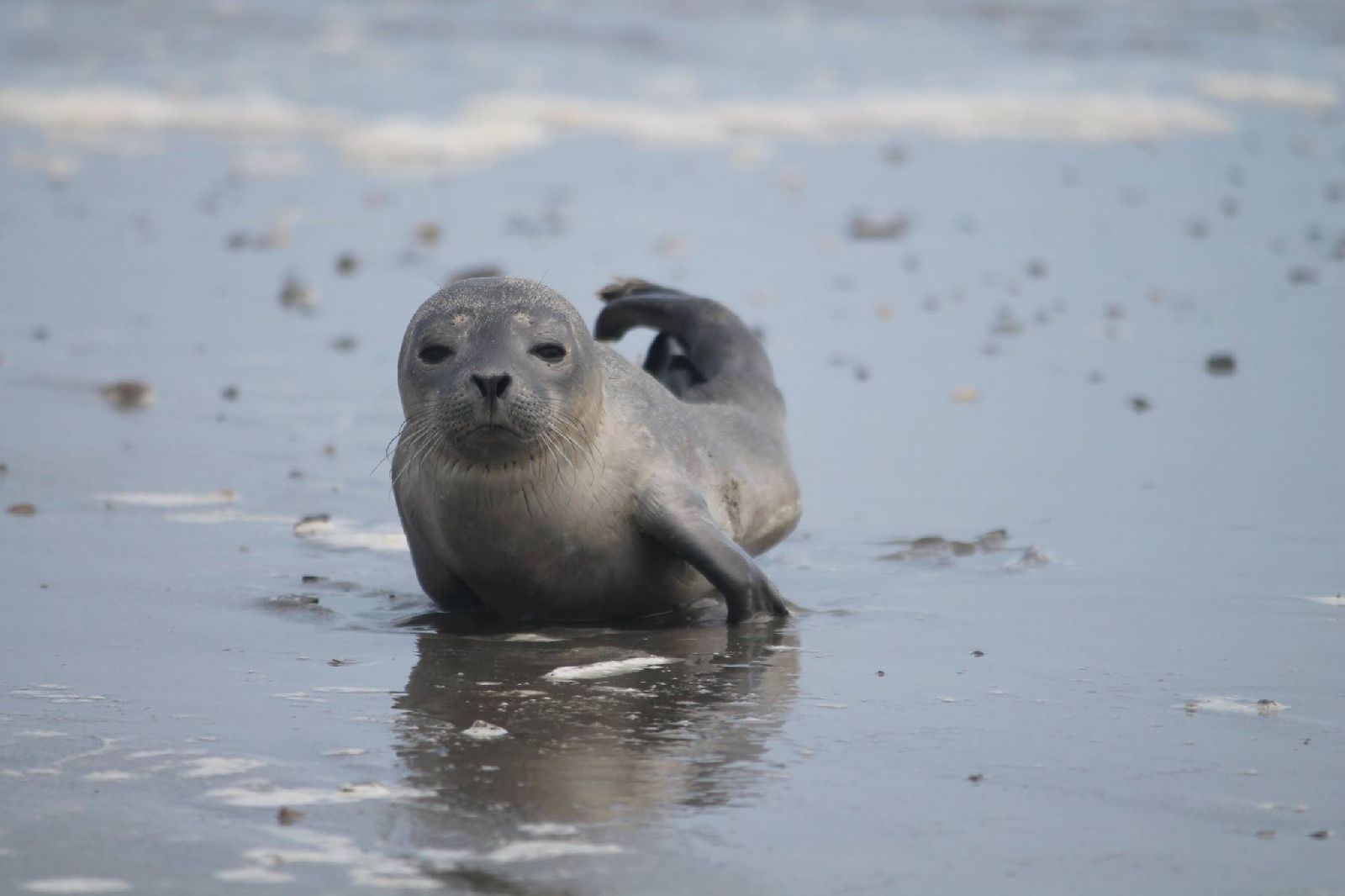 |
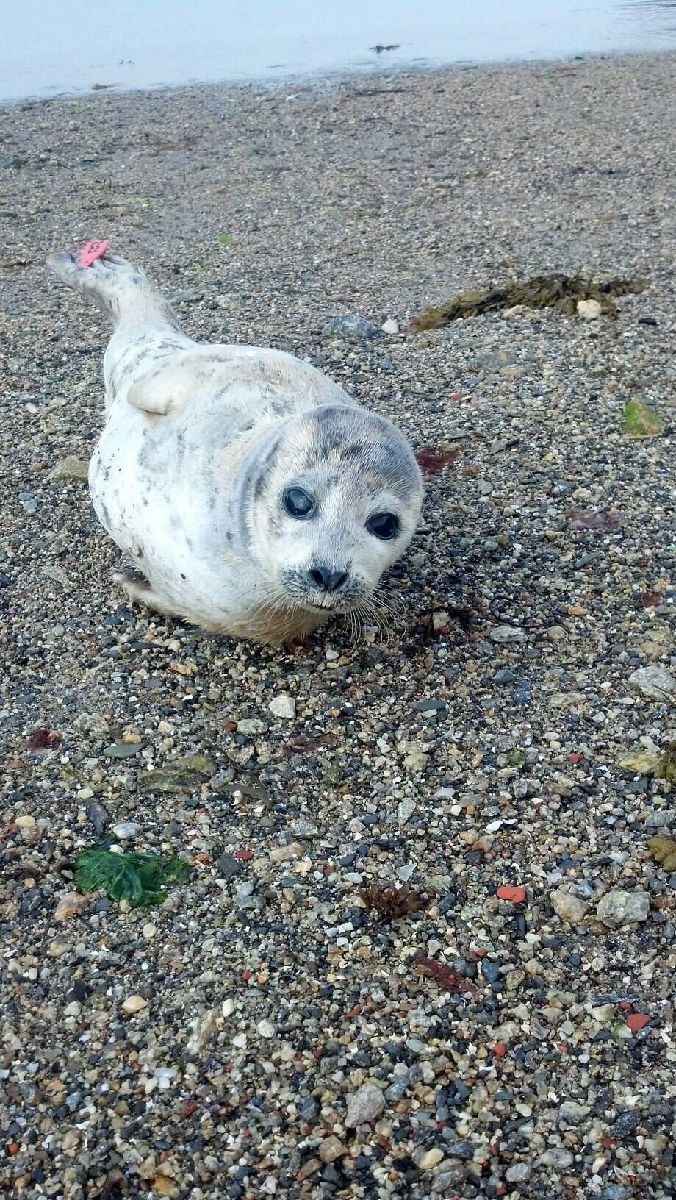 |
On Wednesday July 1st we received reports about 2 different animals. The first was a female weanling harbor seal in Rye on Cable Beach (very northern end of Jenness). She was alert and responsive Wednesday so we put her on what we refer to as a "24 hour monitor". This is to determine how her overall health is progressing and whether she needs help and can survive the 2+ hour transport to rehab. On Thursday morning it was clear that she needed help, as her health was declining rapidly, which commonly happens with these young weanlings (about a month old). She was removed from the beach and transported to National Marine Life Center for rehab, but even though she survived the transport, she was unresponsive at the rehab center and passed on her own. She received a full necropsy by colleagues at New England Aquarium the following day.
Later Wednesday afternoon we received a call from staff on Star Island (Isles of Shoals) about a seal with a flipper tag, that had hauled out in their swimming area. This animal was a female juvenile harp seal! This species of seal is typically only around in the cold winter months. It turns out she was rehabbed by our colleagues at Marine Mammal Stranding Center in NJ and released at the end of April. She was gone the following morning, so she was likely making a pit stop in NH on her trip back up north to the arctic!
June 30, 2015
A busy weekend!
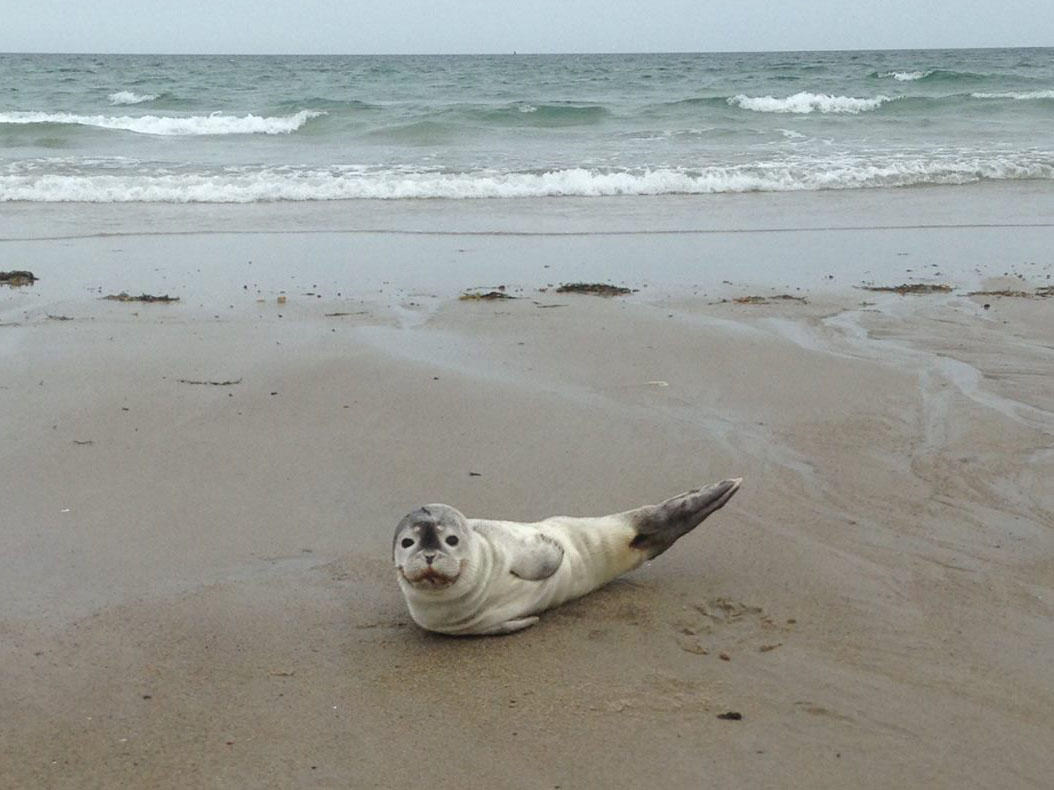 |
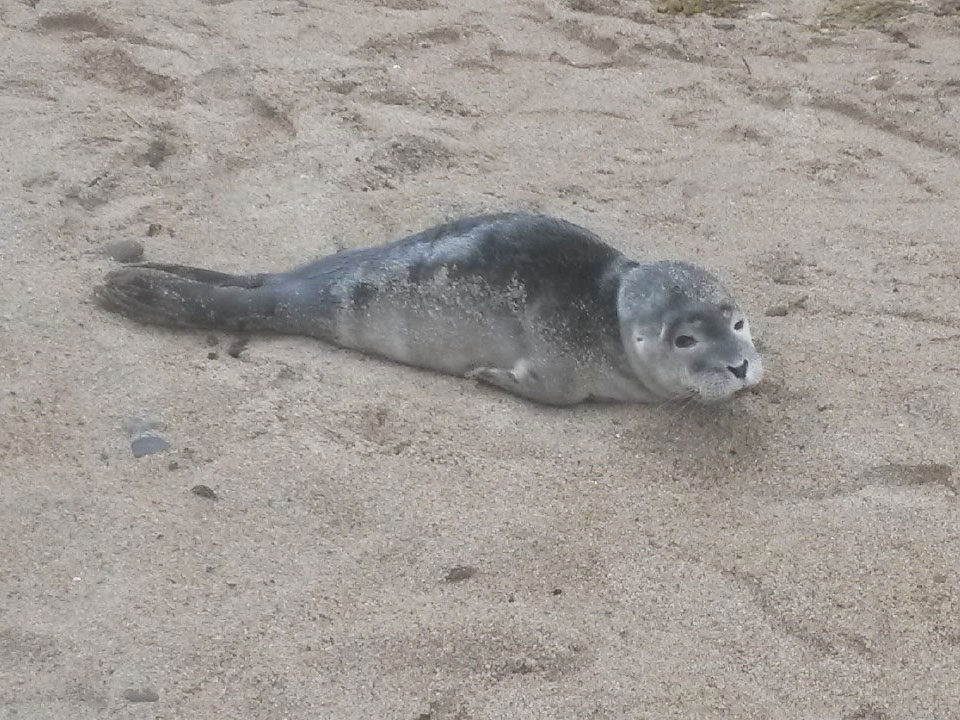 |
This weekend was busy for the rescue team! In addition to a deceased seal, and a live seal in Rye that retreated to the water on its own, we were busy with the female harbor seal pup pictured above. She started on Hampton beach on Saturday June 27th. She was BAR (bright, alert, and responsive) but was thin and had a small wound on her jaw (left). On Sunday, she reappeared on Seabrook Beach and was more lethargic than on Saturday; you can see in the photo on the right that she appears "flat" and has bloodshot eyes and a swollen muzzle. After monitoring her for the weekend, and with declining heath and no sign of mom (if she is still a dependent pup), the decision was made that she needed rehabilitation. On Monday, rescue assistants Sarah Toupin and Nikki Annelli crated her and then transported her to National Marine Life Center in Buzzards Bay, MA where she was given the name Cinnamon. The next few days are critical, but we are holding out hope that she will remain strong! A huge thank you goes out to all of the field volunteers that monitored her over the weekend to keep her and the public at a safe distance from one another, and also to everyone that reported her!
June 2, 2015
Relay is the Name of the Game!
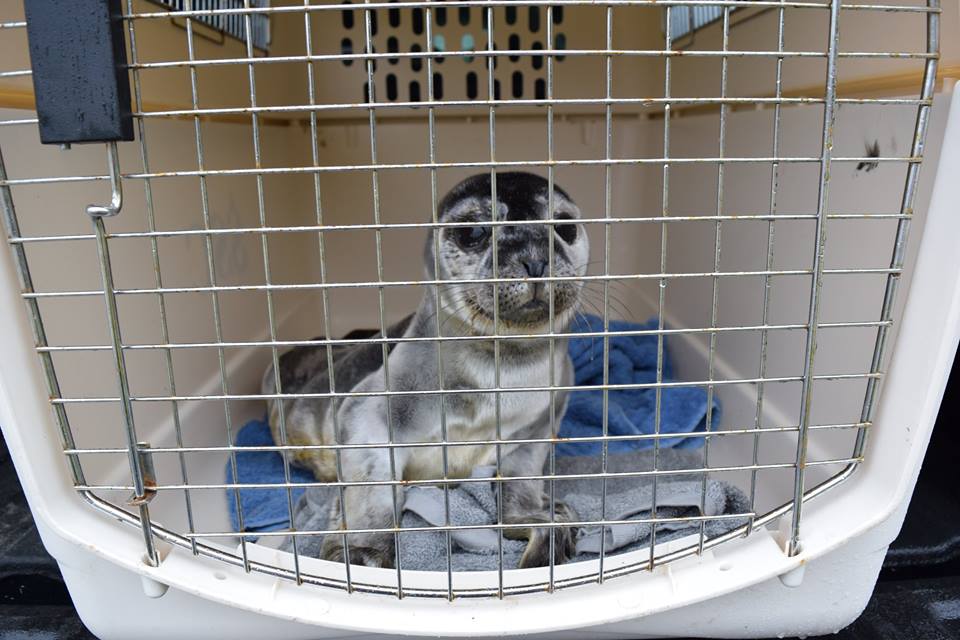 |
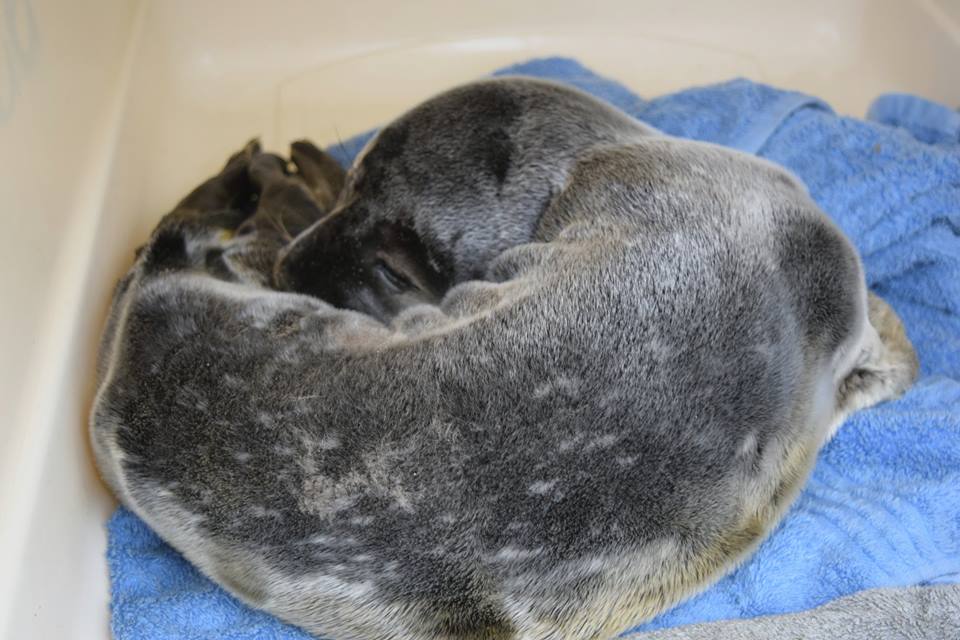 |
Yesterday afternoon we assisted with another tag-team transport. This harbor seal pup from northern Maine needed to go to Mystic Aquarium in CT because the rehab facility in Massachusetts is full. On Sunday he was picked up in Jonesport, ME by volunteers of University of Maine Machias after being monitored on the beach for multiple days by College of the Atlantic/Allied Whale (COA), to see if mom would return. He spent the night with the vet to get some much needed fluids and electrolytes before his trek South. Yesterday morning a COA volunteer picked him up in Camden and transported him to Freeport, ME. From there, another volunteer took him from Freeport, ME to Newburyport, MA where our team met them. We transported him from Newburyport to Waltham, MA where we met a volunteer from Mystic Aquarium, who took the little guy the rest of the way.
He is now getting the care he needs, and is spending some time with other pups like him that are also in rehab! It took 4 organizations to make this transport happen, and it all came together seamlessly. Many thanks to everyone involved!
May 30, 2015
First Local Harbor Pup of the Pupping Season
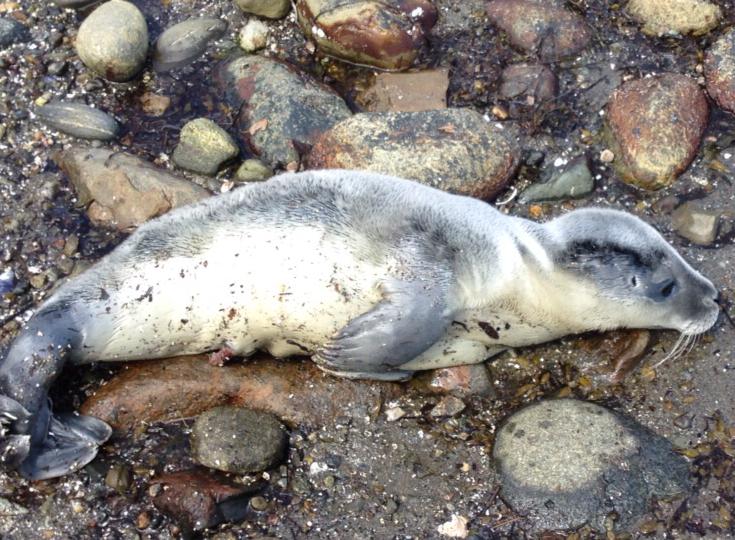
We had our first local harbor seal pup report this morning, at Plaice Cove in Rye. You can see in the photo that this animal still has a small portion of the umbilical cord remaining. As we were working to deploy a responder, it retreated to the water—hopefully, it saw it's mother waiting in the water!
May 28, 2015
Another Stranding Network Relay to Rehab
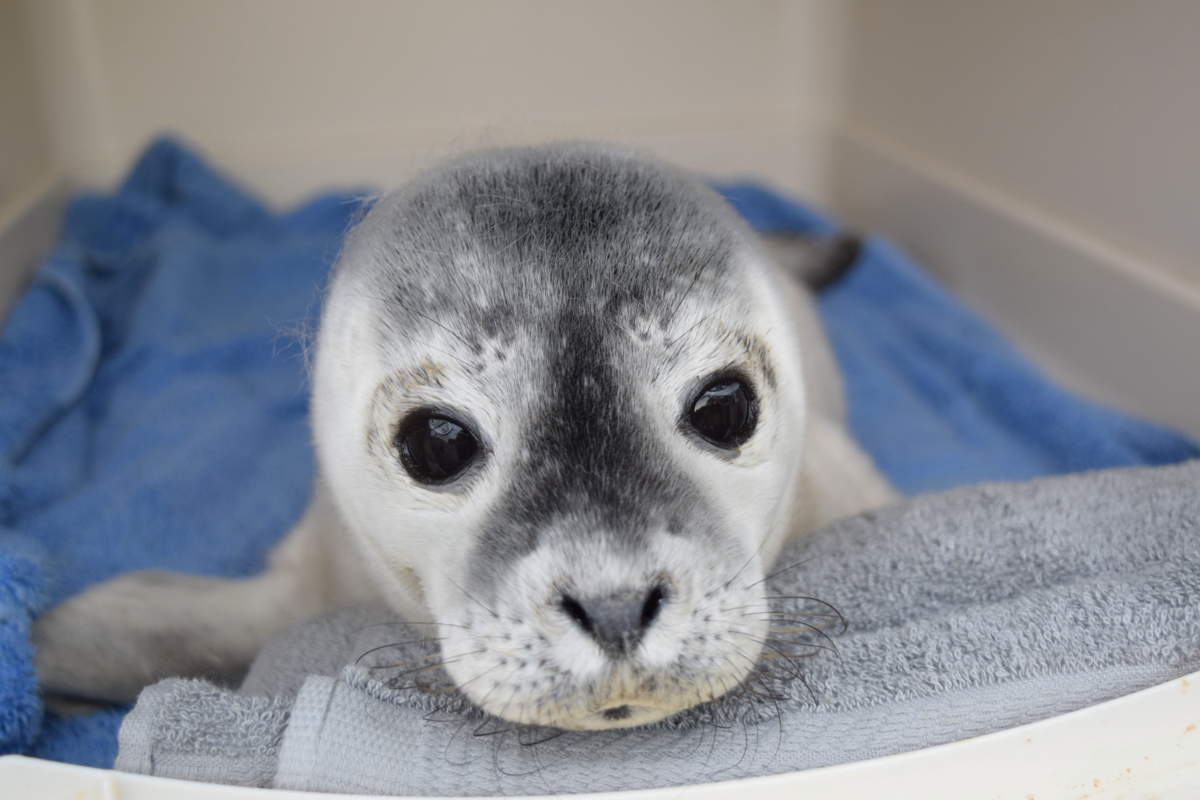 |
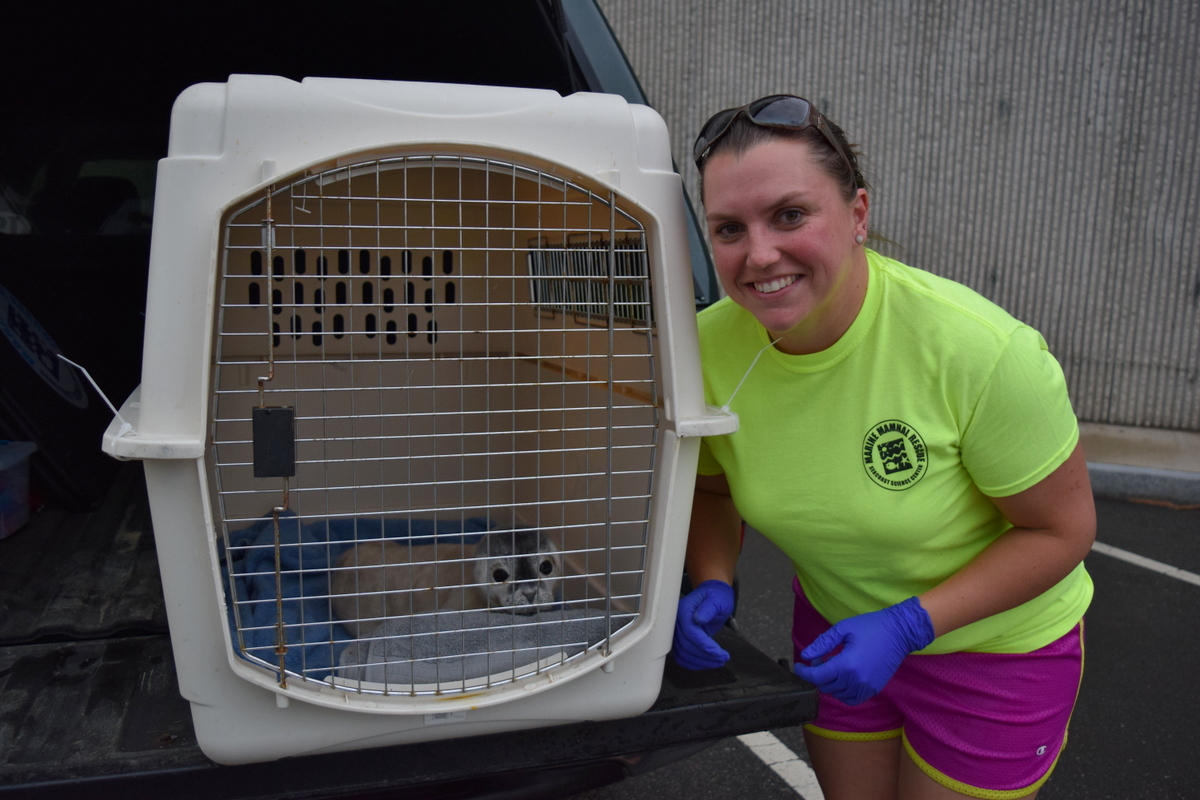 |
This male harbor seal pup, who is still wearing a partial coat of lanugo/birth fur and only has a couple of tooth buds that have erupted from his gums, was first reported in Harrington, Maine on May 24th. After waiting a few days and not seeing any signs of mom returning, the decision was made this morning to pick him up, as dependent pups will not survive without mom. We met College of the Atlantic/Allied Whale at the Newburyport Park and Ride in MA, and drove him to a parking area in Quincy, MA where we met colleagues from National Marine Life Center (NMLC), where this pup will be rehabbed. NMLC is naming all the seals in their care after herbs and spices this year, and named this little guy Mace.
May 20, 2015
Harbor Seal Pupping Season is Underway!
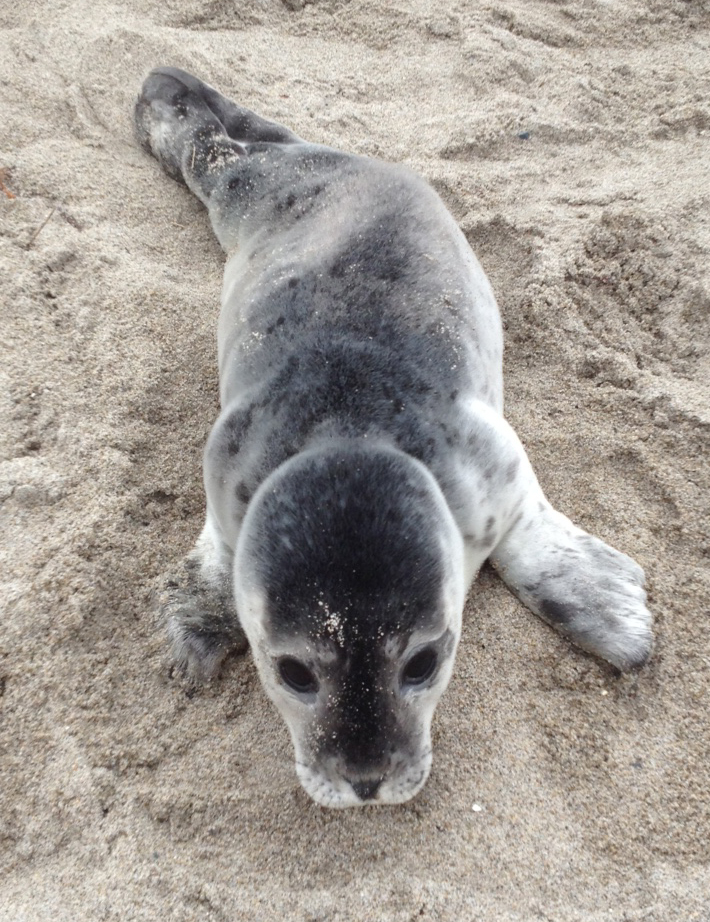 Harbor seals bear their young during the months of May and June. As a result, the chance of seeing seals on our beaches, and more specifically seal pups, increases. If you see a seal on the beach, it is important to keep back and call the Seacoast Science Center’s Marine Mammal Rescue (MMR) hotline at 603-997-9448 for any marine mammal hauled out on the shore in New Hampshire, alive or dead.
Harbor seals bear their young during the months of May and June. As a result, the chance of seeing seals on our beaches, and more specifically seal pups, increases. If you see a seal on the beach, it is important to keep back and call the Seacoast Science Center’s Marine Mammal Rescue (MMR) hotline at 603-997-9448 for any marine mammal hauled out on the shore in New Hampshire, alive or dead.
“It is vital that we do not interrupt the important bond being formed between a mother seal and her pup during this time,” said MMR Coordinator Ashley Stokes. “The mother seal may leave her pup on the beach while she is off feeding and it is critical that we give the pup space so the mother is will to return to it.”
Seals are only semi-aquatic, meaning that it’s normal for them to spend time hauled out on land. But there are times when a marine mammal comes up on shore because it is sick or injured. “We recover, gather data on, and record photos of deceased animals to monitor causes of mortalities (natural or human caused) that could pose health risks to marine mammal populations, people or pets. This is why it is important that beachgoers call our hotline as soon as an animal is spotted.”
What to do if you spot a marine mammal on shore in New Hampshire:
- - Call the Seacoast Science Center’s 24-hour Marine Mammal Rescue hotline at 603-997-9448
- - Report the exact location, if it's live or dead, and details about it's size, coloring, and behavior
- - Always maintain a safe distance (at least 150 feet) from the animal to avoid injury to you or the animal.
The Seacoast Science Center’s MMR team responded to 72 seals (58 harbor seals, 4 gray seals, 3 harp seals, 1 hooded seal and 6 unknown) and 1 harbor porpoise during its 2014 inaugural year.
New Hampshire’s marine mammal rescue effort costs $70,000 on an average year and the seals can’t pay. That’s why the Center relies on contributions to keep its hotline up and team ready to respond.
To inspire others to give, New Castle residents Cyrus and Bobbie Sweet have issued a challenge: they will match every dollar that is donated to the rescue effort this year—up to $20,000! That means every dollar you give will go twice as far. To donate, click here.
May 17, 2015
Hampton Beach Gray Seal Succumbs to Illness
We are saddened to share that Thyme (the grey seal our team rescued from Hampton Beach on Saturday 5/16) took a turn for the worse on June 17 and succumbed to her illness. She seemed well the afternoon following her admittance to NMLC, through the night and on Sunday morning, but she experienced a long episode of seizing and passed in the afternoon.
Thank you to everyone involved in this case, including the volunteer field responders, reporting parties, beach goers who watched the rescue and had words of encouragement, and to our colleagues at National Marine Life Center who did their best in the beginning stages of rehab for this young seal.
May 16, 2015
Weanling Gray Seal on Hampton Beach
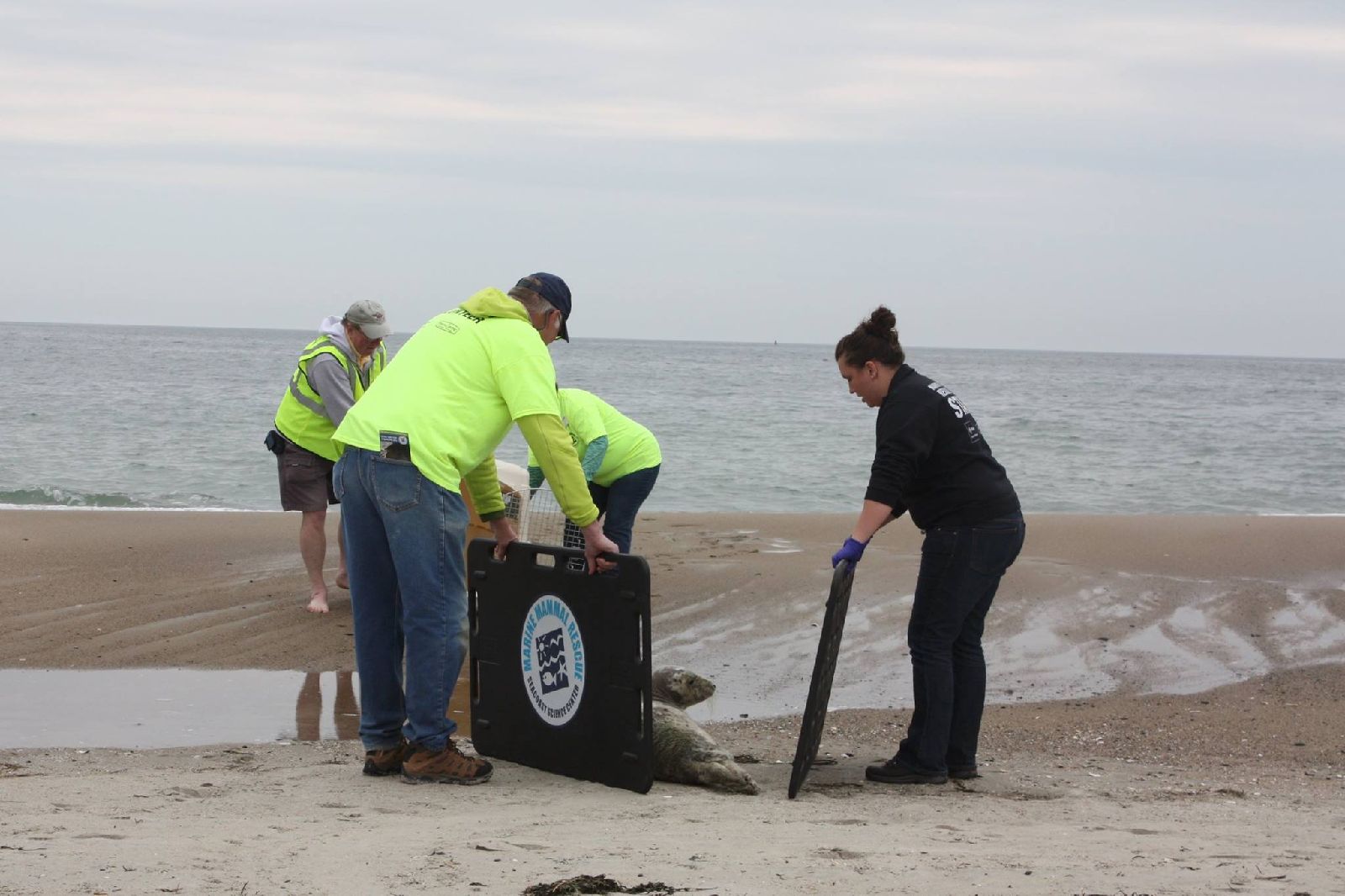
.jpg)
This morning our team removed this female weanling Gray Seal from Hampton Beach. After getting a few phone calls about her very early this morning, we learned that she has been there since yesterday morning. She was suffering from alopecia (hair loss) over about 45% of her body, skin parasites, and a swollen and painful (she showed pain response when that area was palpated) left hind flipper joint. She was taken down to National Marine Life Center in Buzzards Bay, MA where she will receive the care and meds that she needs. Keep your flippers crossed that she can make a full recovery and be released back into the wild in the near future. Thank you to those that reported this seal to us, to all of the volunteer field responders that assisted, and to NMLC for giving this seal the care she needs!
May 14, 2015
Northern NE Network Members Collaborate to Save Seal
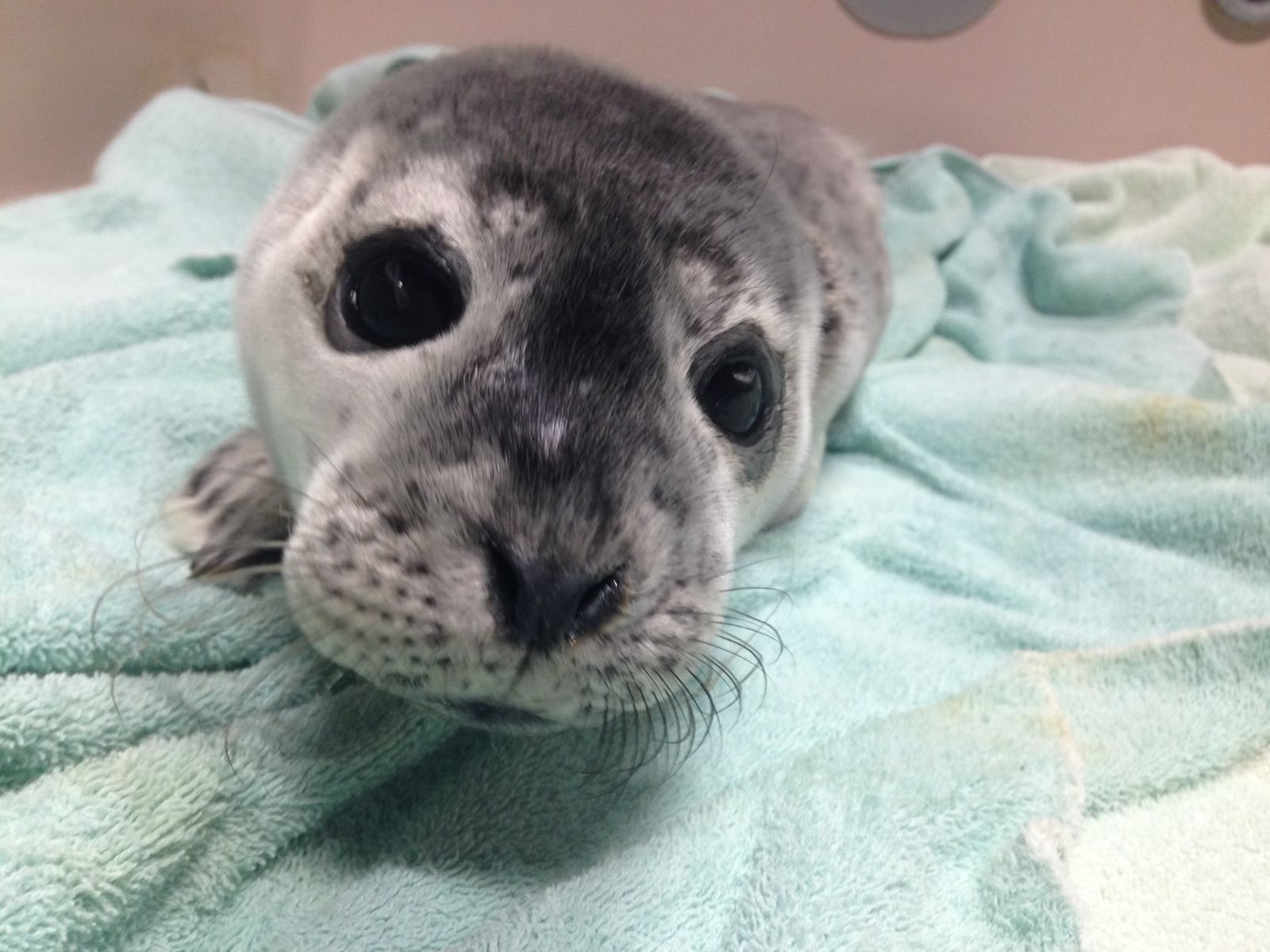 Our Marine Mammal Rescue Team (MMRT) assisted with the rescue of a harbor seal pup on May 14, through a transportation relay to rehabilitation at the National Marine Life Center in Buzzards Bay, MA.
Our Marine Mammal Rescue Team (MMRT) assisted with the rescue of a harbor seal pup on May 14, through a transportation relay to rehabilitation at the National Marine Life Center in Buzzards Bay, MA.
The week-old male pup, abandoned by its mother on the coast of Deer Isle, Maine, was first assessed by fellow Greater Atlantic Regional Fisheries Office Stranding Network team members from the College of the Atlantic, Allied Whale, Bar Harbor, ME. Because the young pup was still dependent on its mother, it would not have survived on its own.
The New Hampshire MMRT met their Maine colleagues at the New Hampshire border and transported the animal to a renevouz point in Massachusetts for the hand-off to the National Marine Life Center.
According to MMRT Coordinator Ashley Stokes, “The closest rehabilitation facility is located in Buzzards Bay, MA, making transporting animals a challenge for all northern New England Network members. Collaborations such as this one are so important.”
The pup was in good condition the morning following the rescue. While still in the critical phase of rehabilitation, the team has high hopes that he will remain strong and will be released back into the wild this summer.
May 6, 2015
Weanling Gray Seal at Rye Harbor State Park
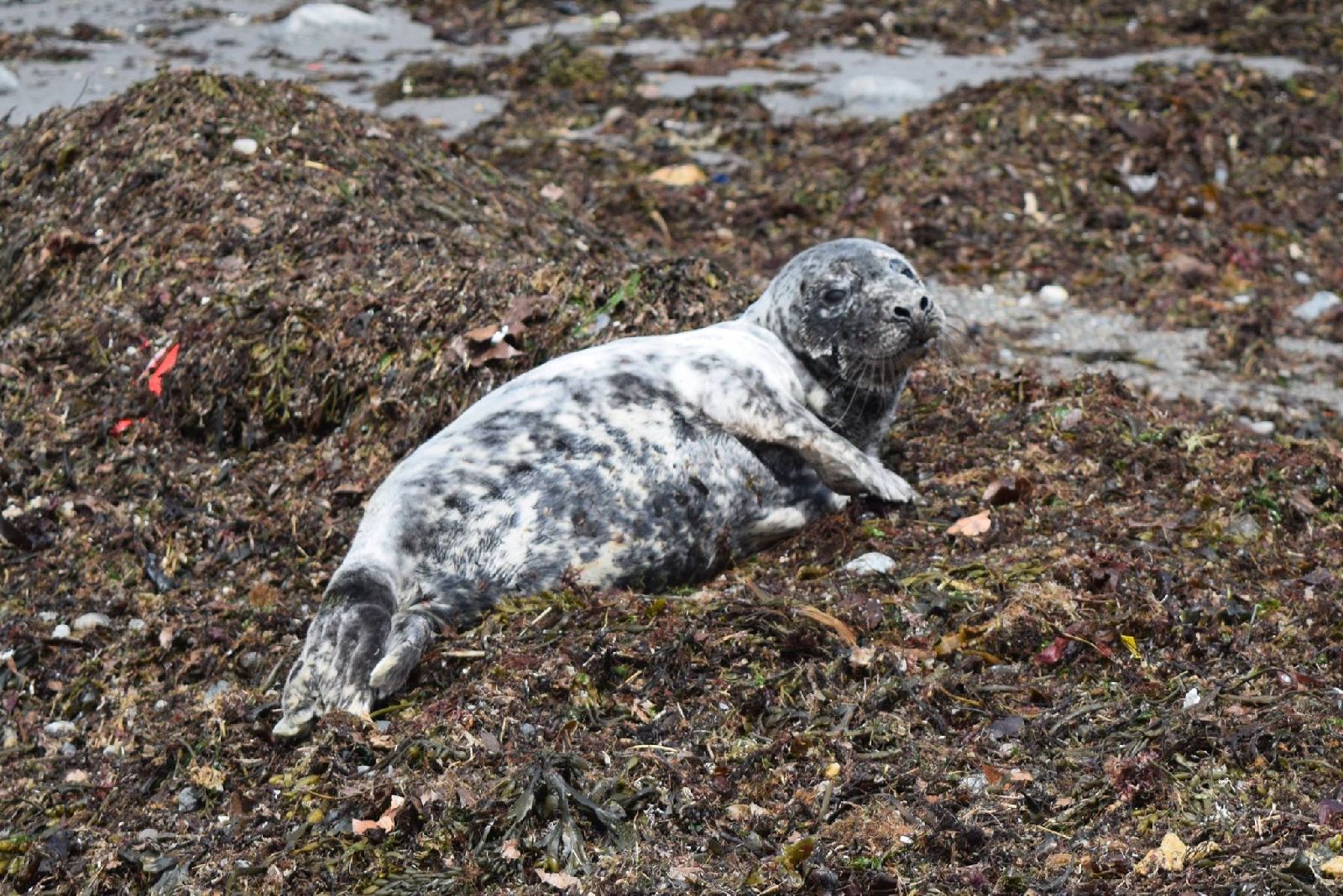 This weanling gray seal at Rye Harbor State Park kept our staff and volunteers very busy this weekend! She was first reported late morning Friday, May 1st. After a visual health assessment and photos were taken, we decided to put her on a 24-hour watch, as she was BAR (bright, alert, and responsive) and vocal, which is what we like to see in these animals. She did still have some lanugo fur (birth coat) remaining, which is surprising because gray seals are normally born Jan-Feb. On Saturday late morning, her health appeared to be slightly worse than Friday and declined mildly throughout the day. She was coughing and uncomfortable, so after consulting our veterinarian and colleagues, the decision was made that she be taken to rehab, but because of the timing, we needed to wait until first thing the following morning. But early morning Sunday, it was clear that the tide had been higher than normal and the seal had no choice but to retreat to the water. We have not received any further reports on this animal as of yet.
This weanling gray seal at Rye Harbor State Park kept our staff and volunteers very busy this weekend! She was first reported late morning Friday, May 1st. After a visual health assessment and photos were taken, we decided to put her on a 24-hour watch, as she was BAR (bright, alert, and responsive) and vocal, which is what we like to see in these animals. She did still have some lanugo fur (birth coat) remaining, which is surprising because gray seals are normally born Jan-Feb. On Saturday late morning, her health appeared to be slightly worse than Friday and declined mildly throughout the day. She was coughing and uncomfortable, so after consulting our veterinarian and colleagues, the decision was made that she be taken to rehab, but because of the timing, we needed to wait until first thing the following morning. But early morning Sunday, it was clear that the tide had been higher than normal and the seal had no choice but to retreat to the water. We have not received any further reports on this animal as of yet.
A huge thank you to all of the staff and volunteer field responders that spent lots of time monitoring this animal and keeping her, and the public, a safe distance from one another!
April 5, 2015
Easter Seals!
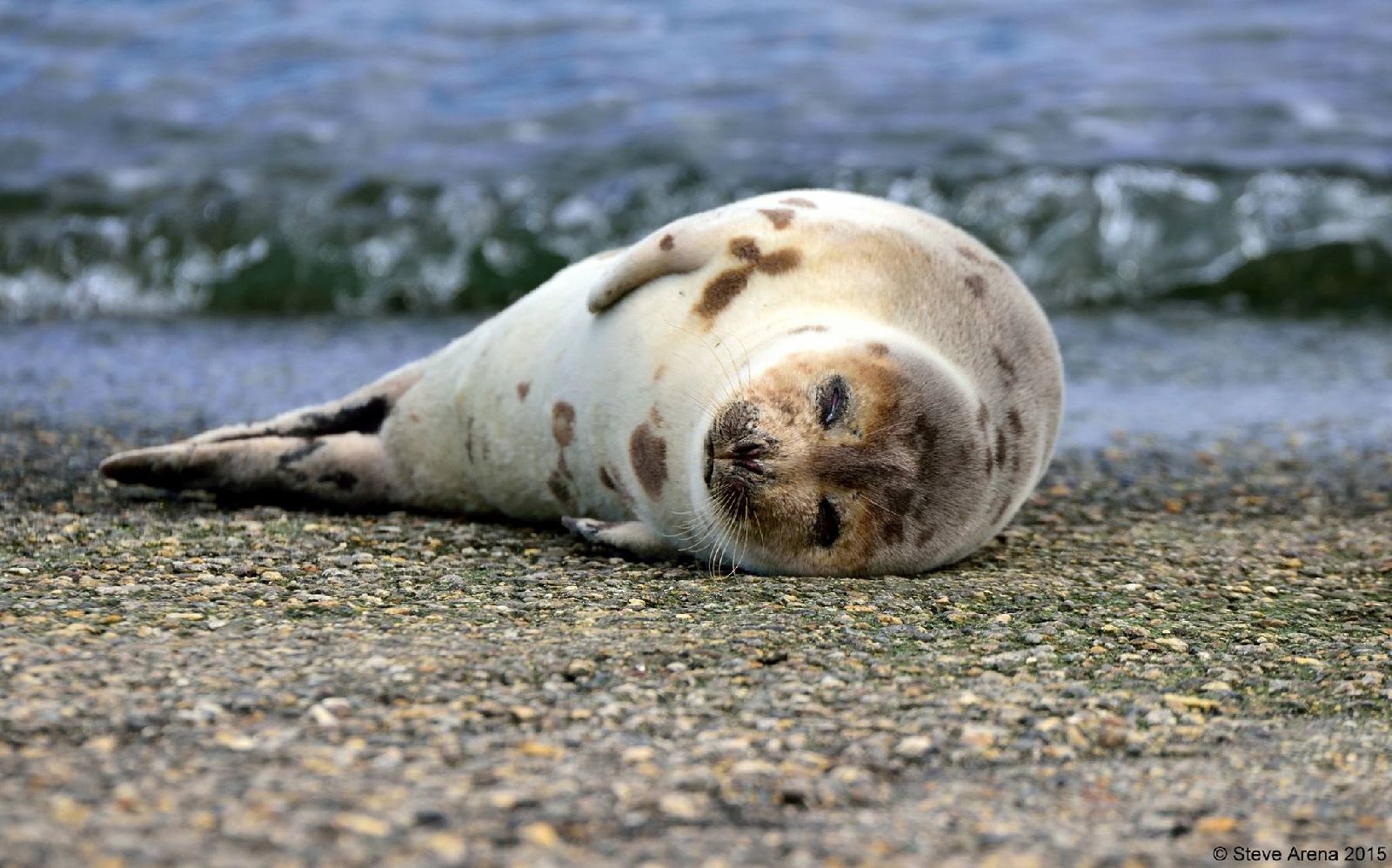 |
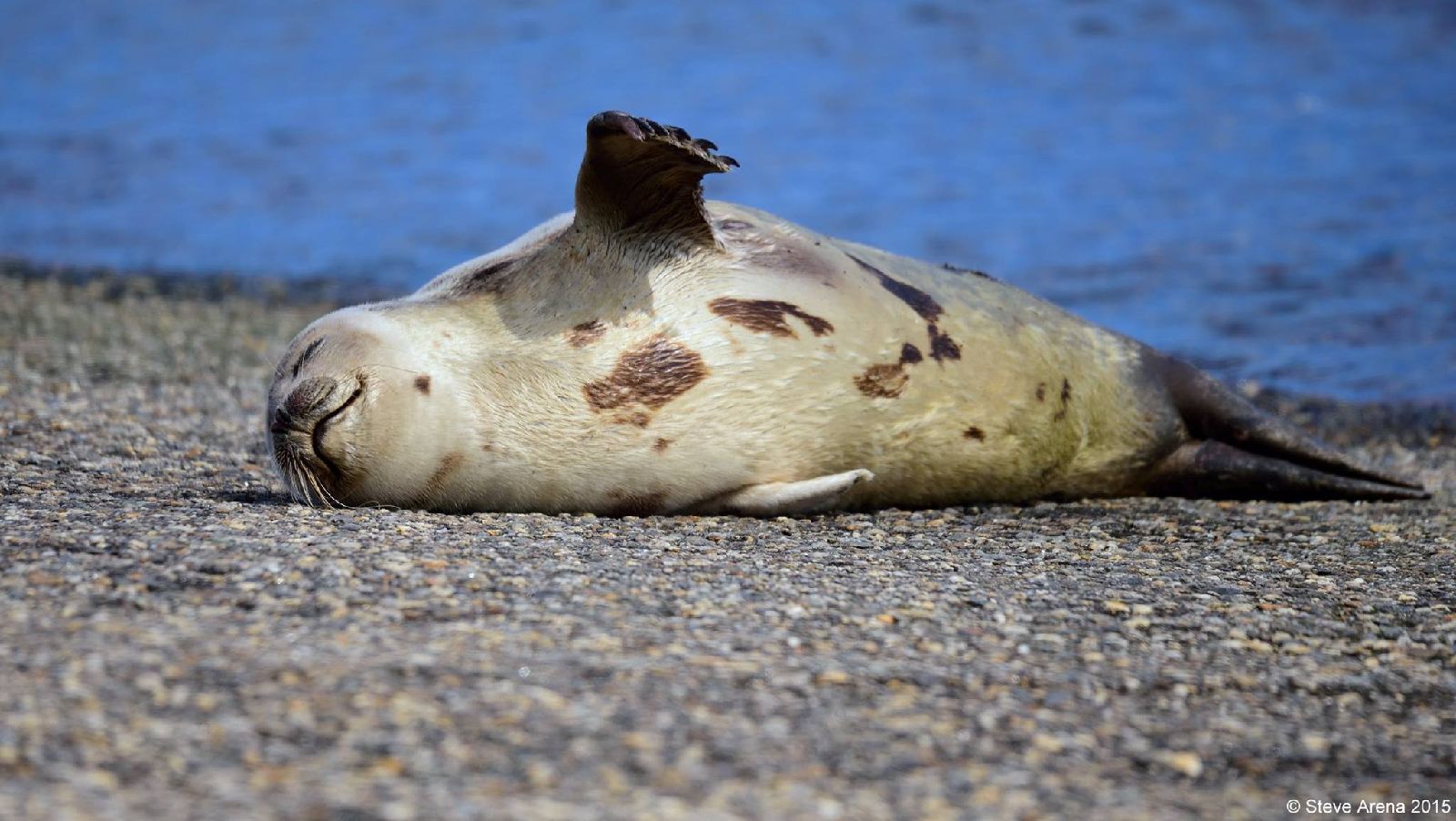 |
Rather than receiving a visit from the Easter Bunny, our Marine Mammal Rescue Team was busy with visits from two Harp Seals in Rye!
The first seal was at the northern end of Jenness Beach (Cable Rd beach access) and was "BAR", moving around a lot, and retreated to the water as the beach got busy with morning joggers and walkers, many with dogs (top photo).
The second seal was hauled out on the paved boat ramp at Rye Harbor. He was very quiet, but did perk up when he heard noises. You may notice in the photos that he had some hair loss on his flippers and irritated eyes, but because his overall body condition was okay, we decided to monitor him before making a decision as to whether he needed intervention. Just before dusk, he decided he was ready to head back to the ocean and we have not received any further sightings.
We thank everyone involved with these cases that took time out of their holiday to spend with these seals!
April 3, 2015
Harp Seal on North Beach
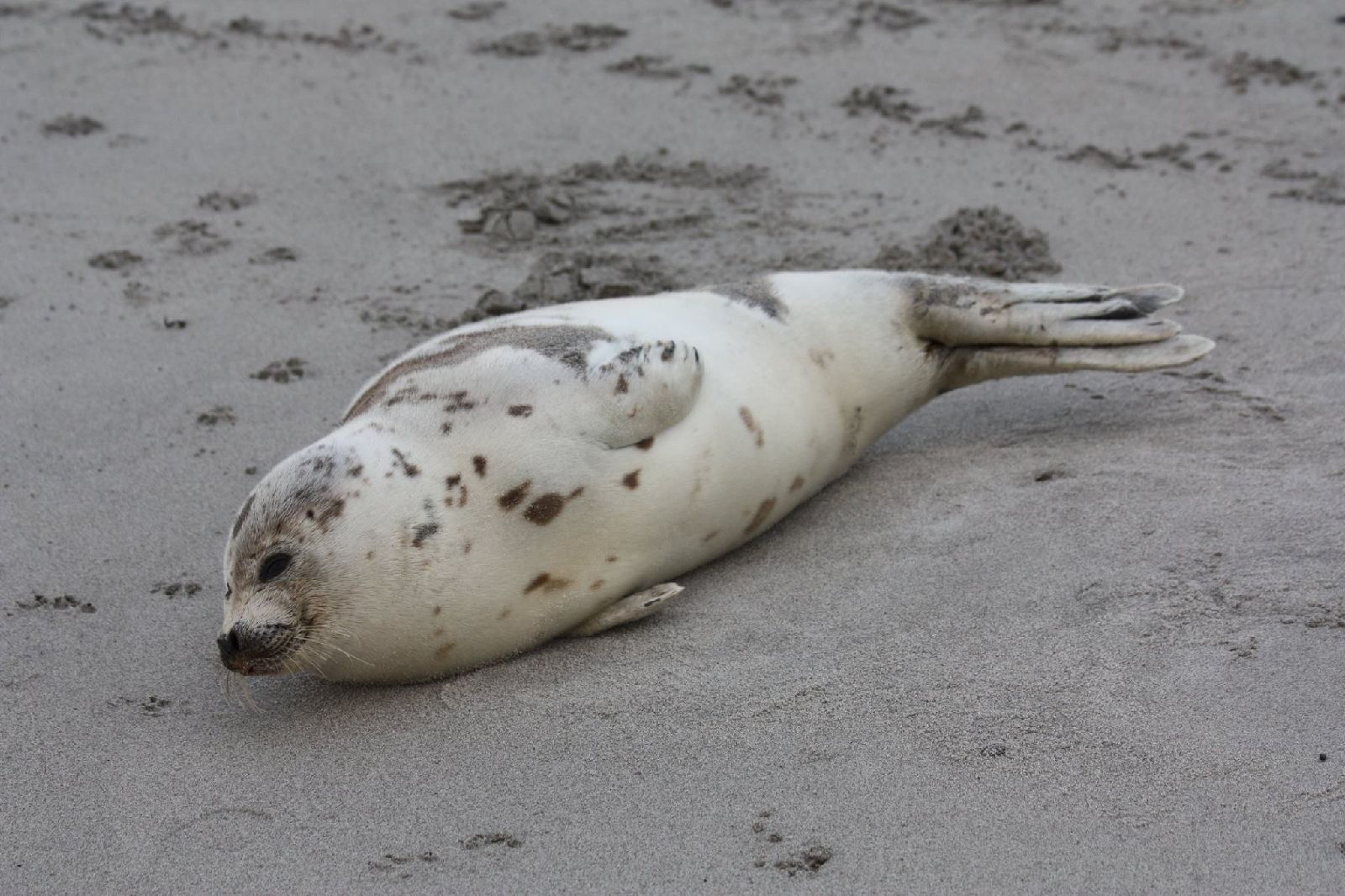 |
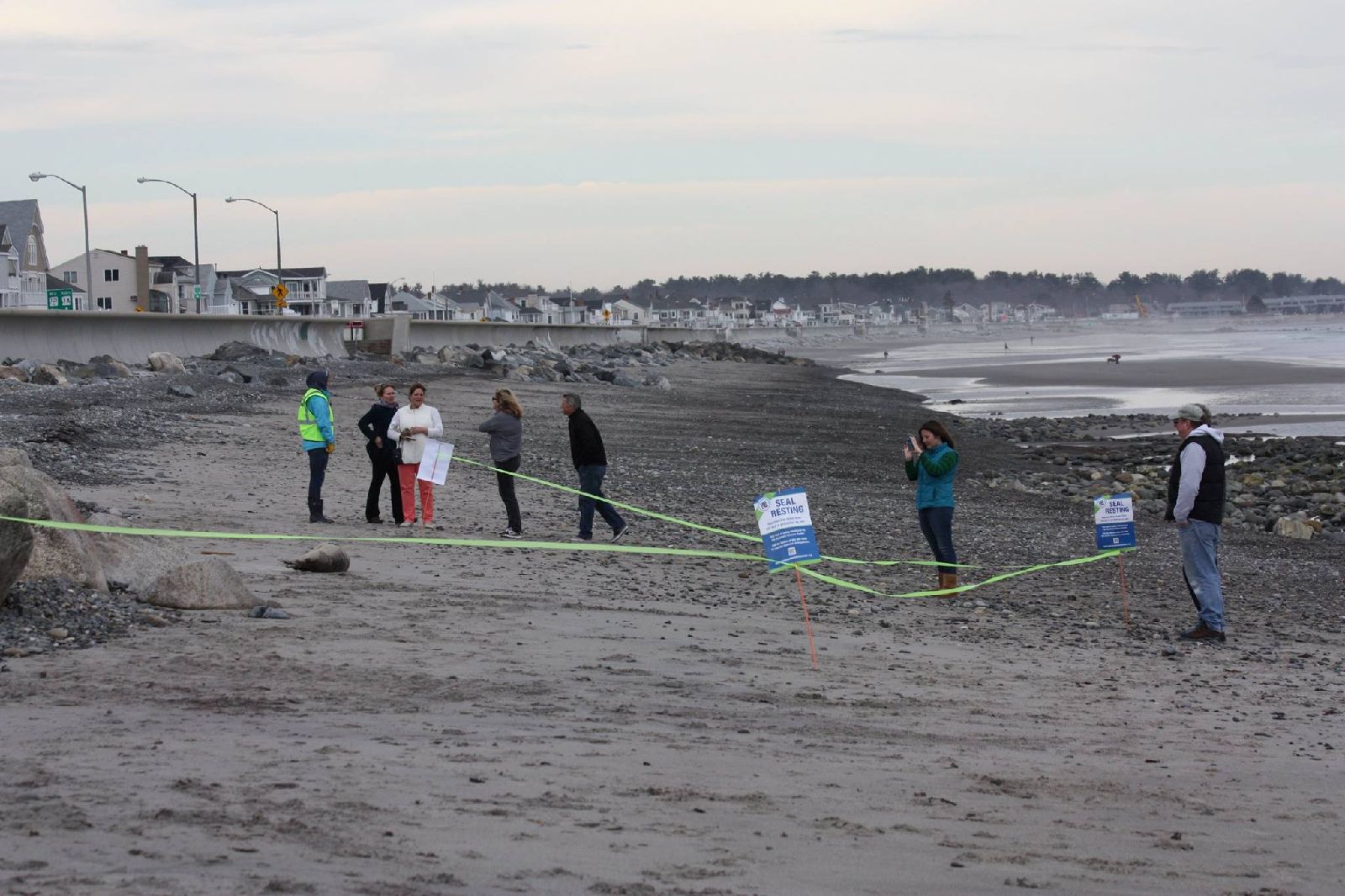 |
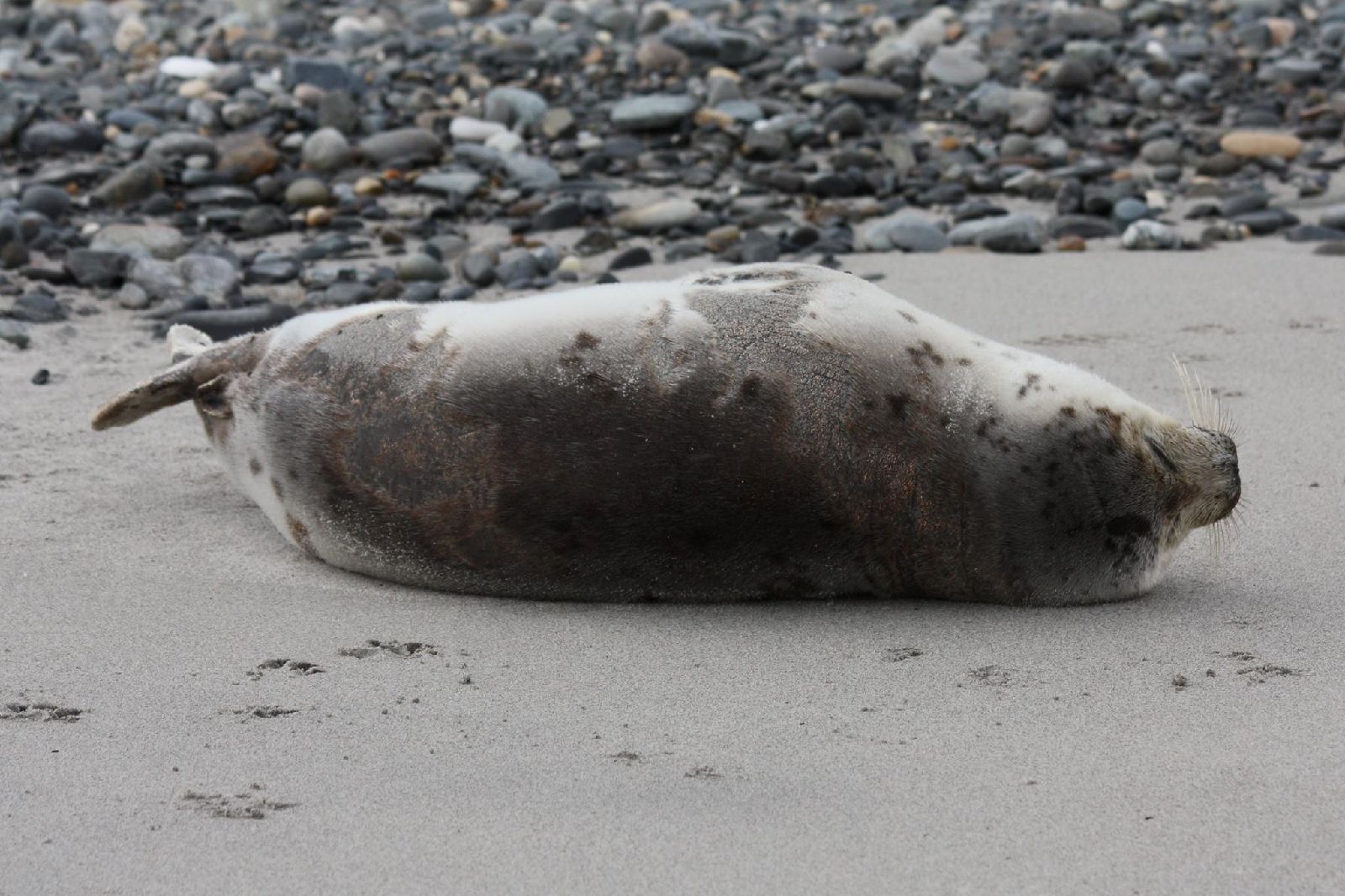 |
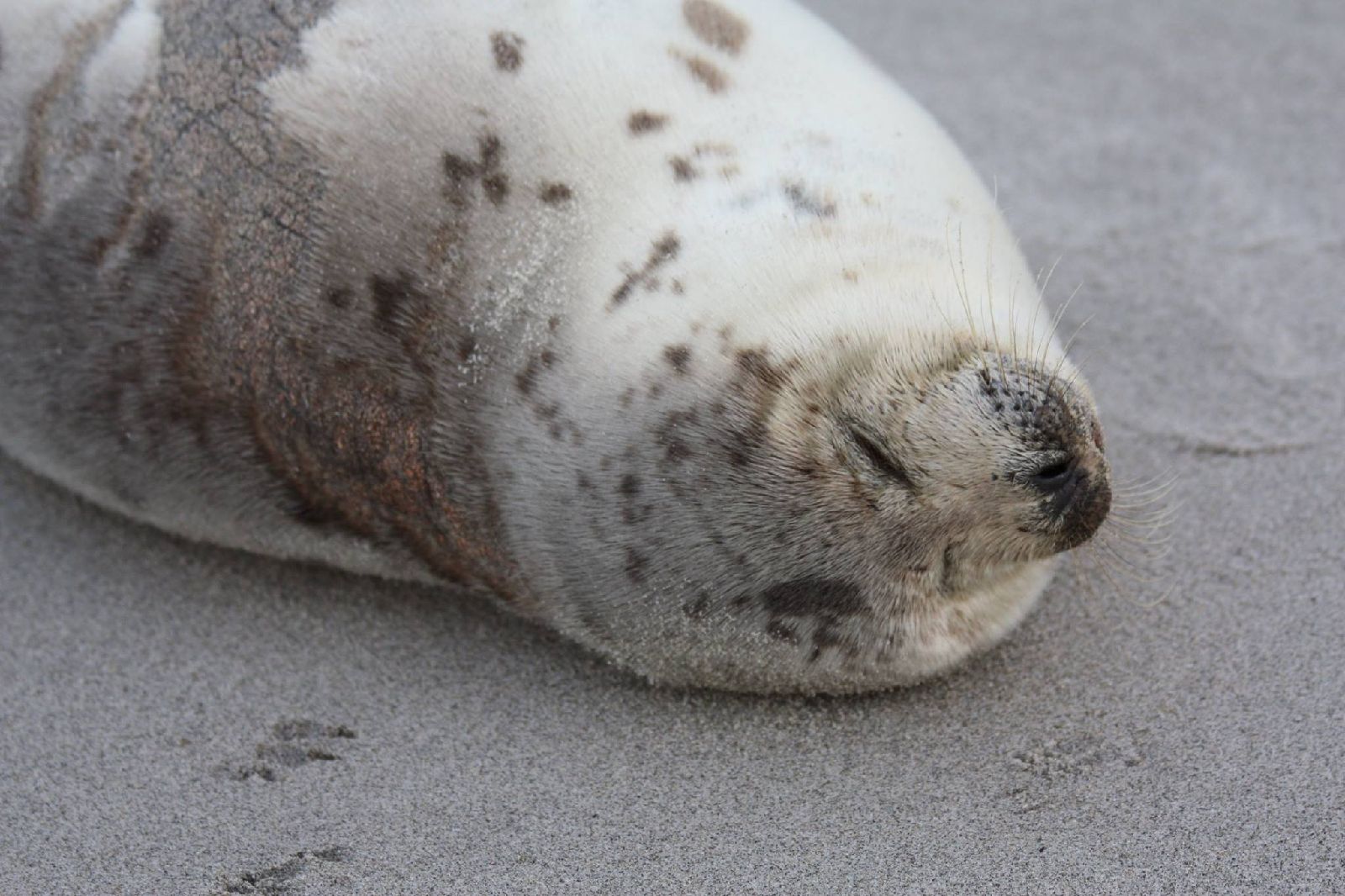 |
The male harp seal did have what is likely a fungal form of alopecia (hair loss), but other than that he was "BAR" (bright, alert, and responsive) and had good body weight, two things we like to see. In the bottom two photos, you can see the patches of alopecia (hair loss) but this is a very moderate case and the seal appeared otherwise healthy, so intervention wasn't necessary at this stage.
March 28, 2015
Common Dolphin Washed Ashore
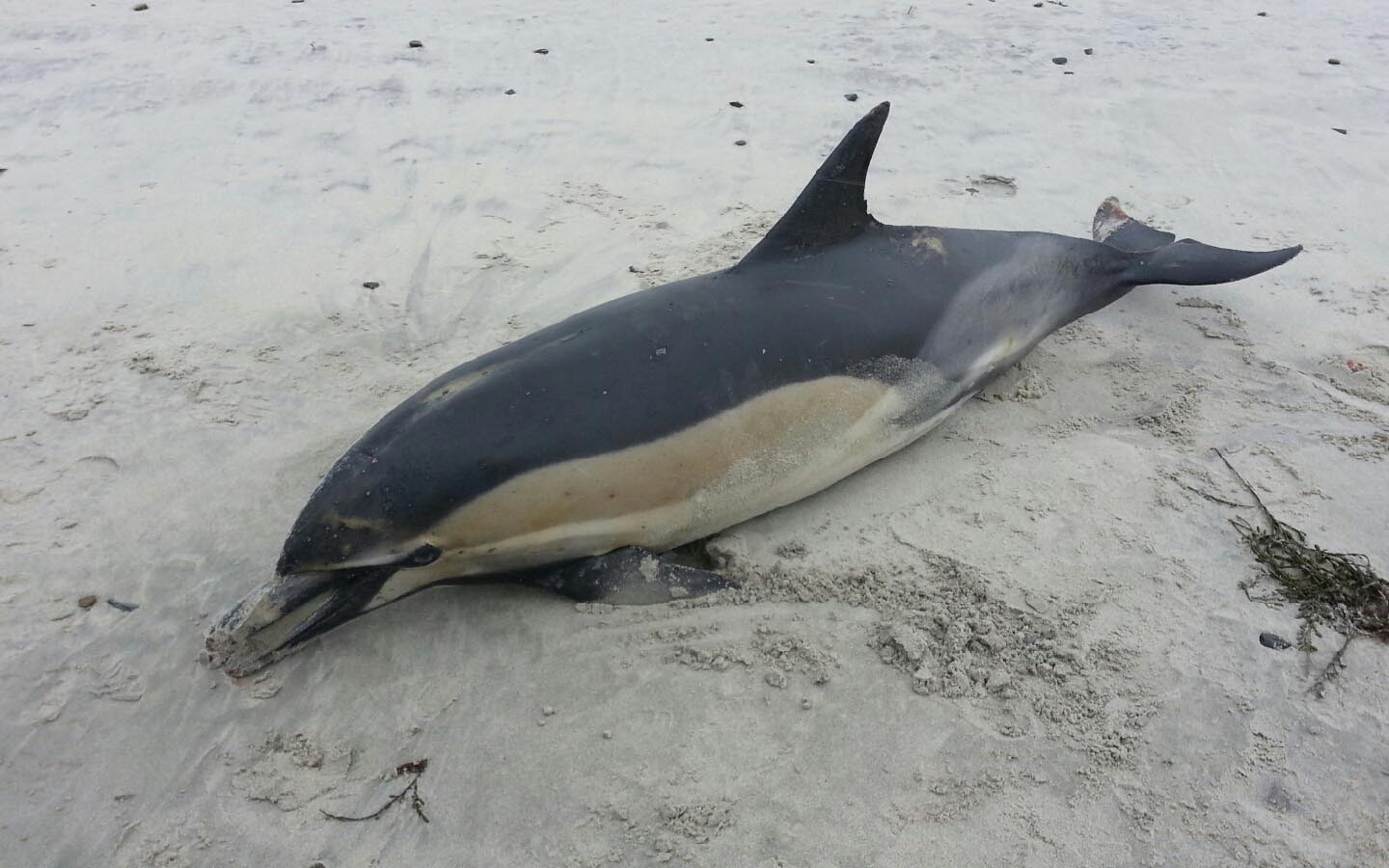 |
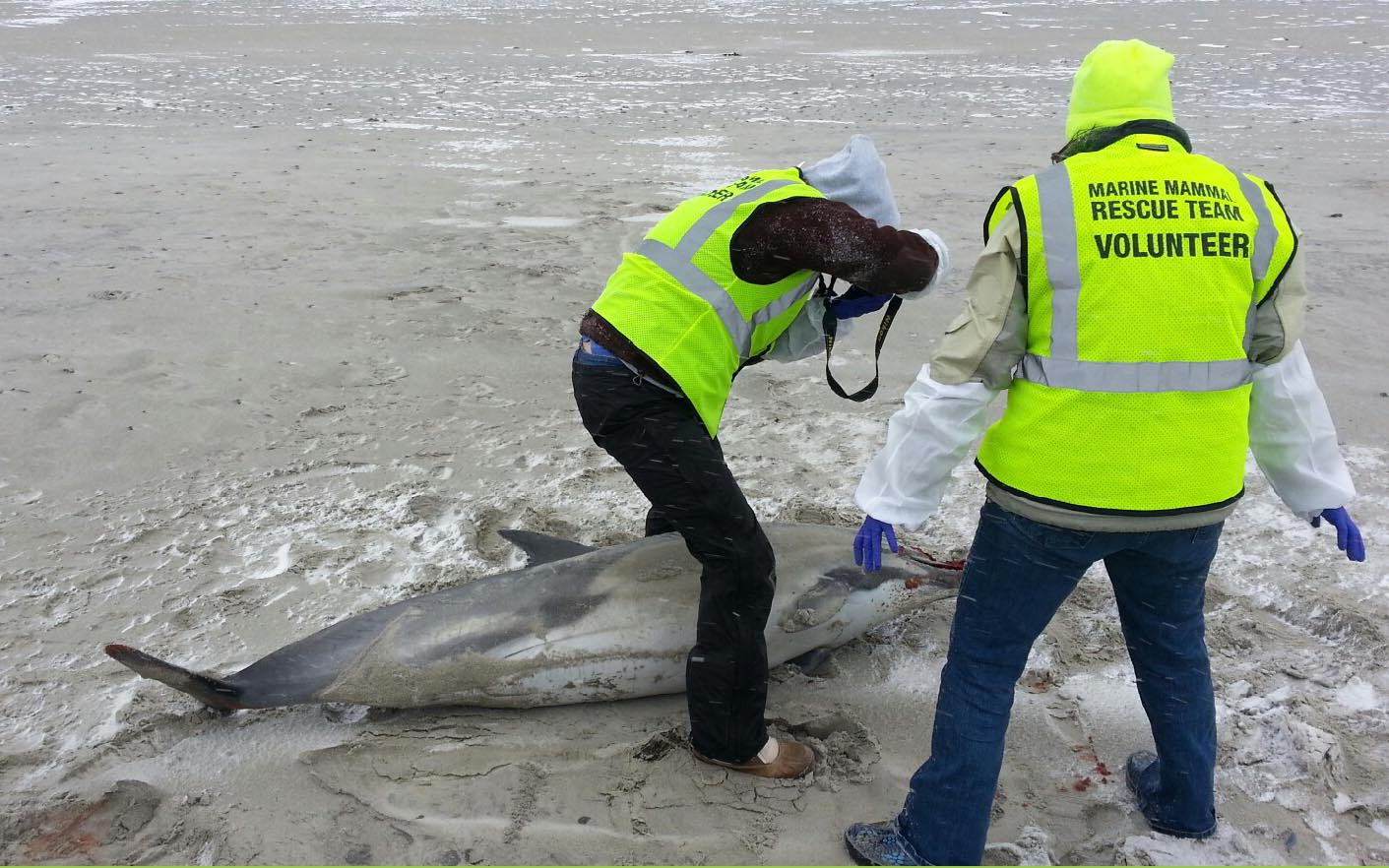 |
March 25, 2015
Grey Seal Pup on Crane's Beach, Ipswich, MA
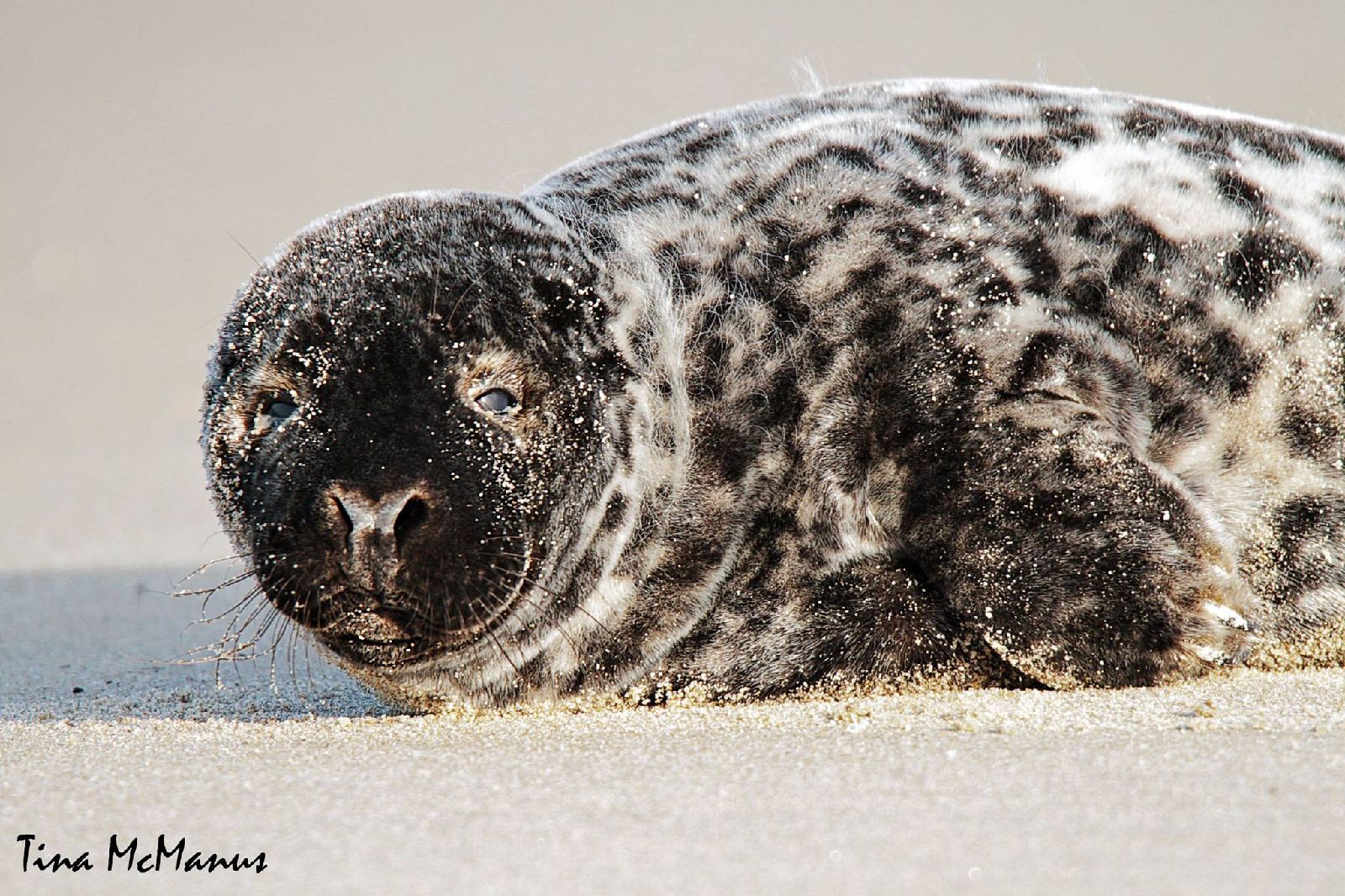 |
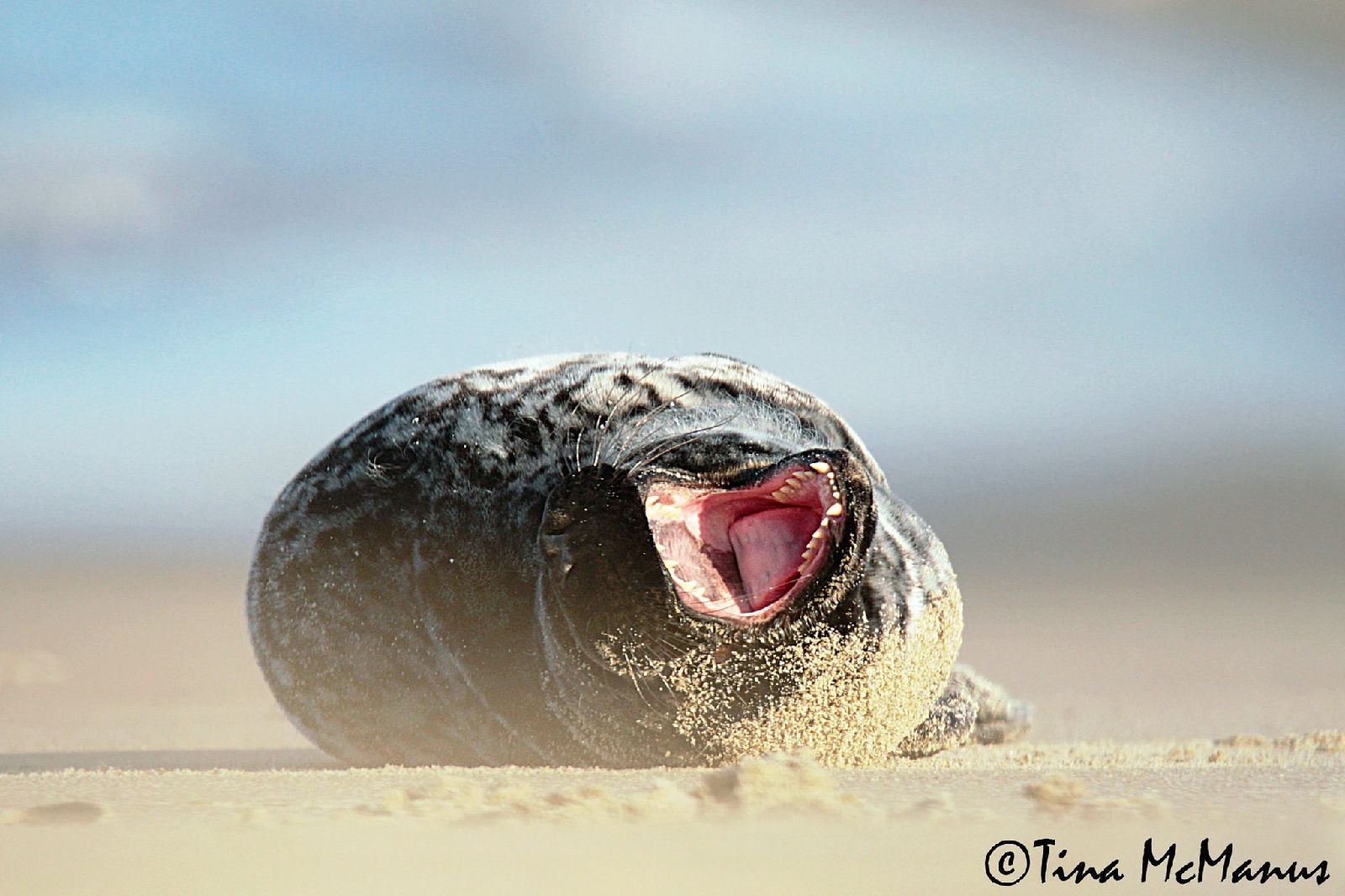 |
On Wednesday, March 25, this grey seal pup hauled out on Crane's Beach in Ipswich, MA. MMR was called to respond, as we are now assisting NOAA with the uncovered northern Massachusetts territory. You can see in the photos taken by the reporting party, that this young seal is still shedding his lanugo (birth) coat; the white straggly looking fur. He was a bit thin, appeared to be slightly dehydrated, and had quite a bit of yellow discharge coming from both eyes. Unfortunately, we didn't hear about this animal until later in the day after he had retreated into the water, so we were not able to preform an on-scene health assessment. If you happen to frequent that area and spot any marine mammal on the beach, live or dead, please call our hotline at 603-997-9448.
Special thanks to Tina McManus for sharing these great photos (taken from a distance with a 600mm lens).
March 9, 2015
Harp Seal Rescued off Rye Harbor Marsh
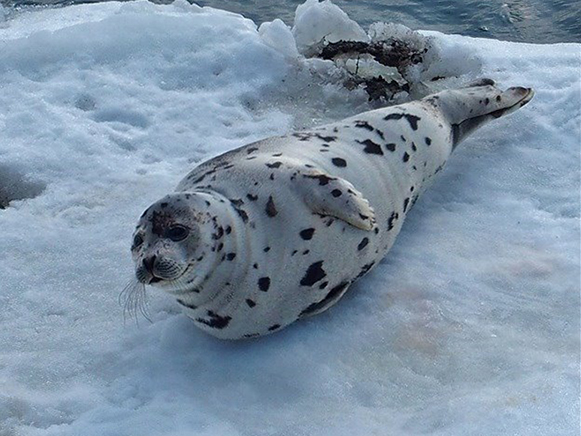 |
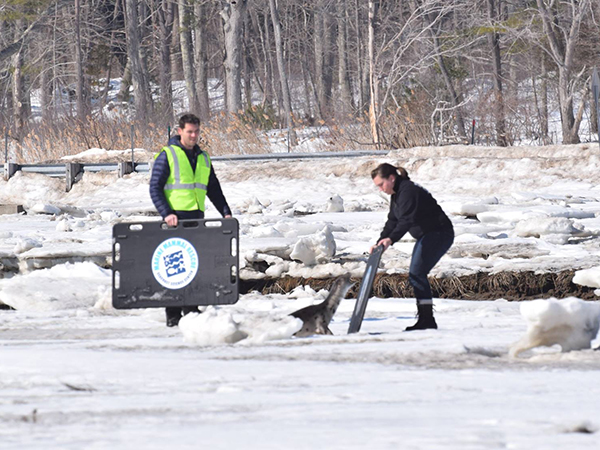 |
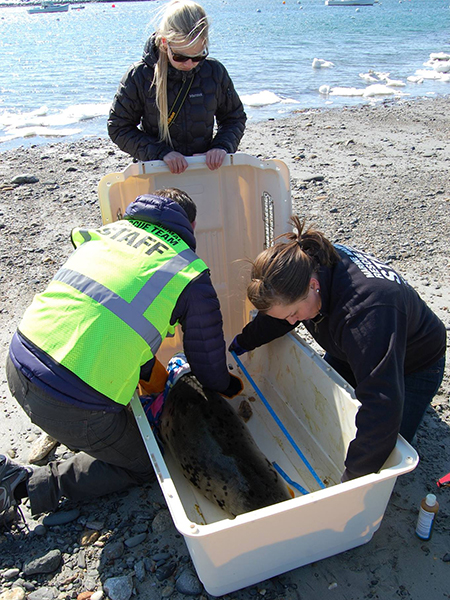 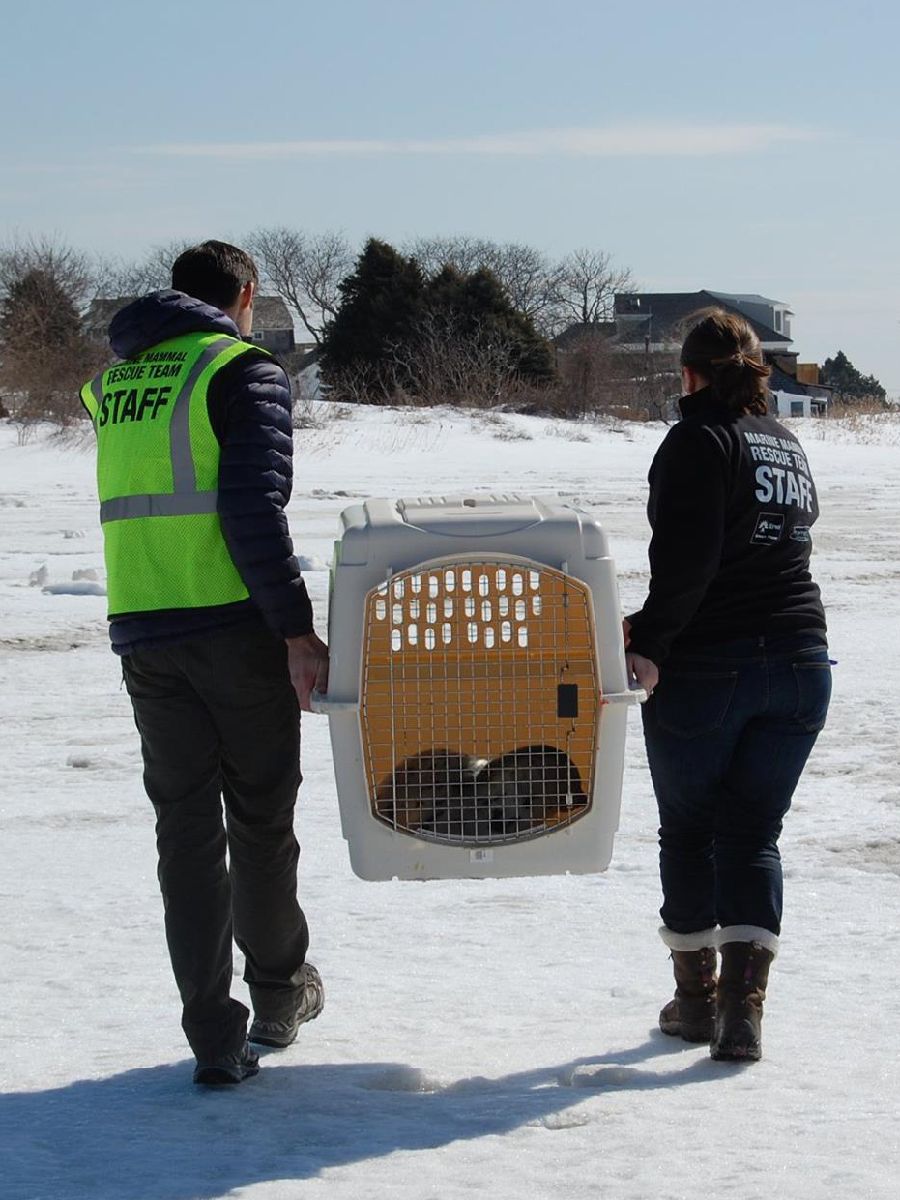 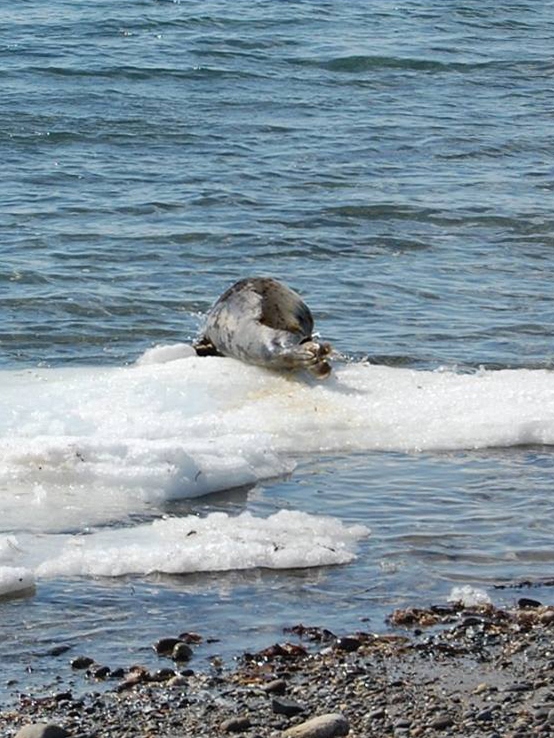 |
The Marine Mammal Rescue Team relocated this juvenile harp seal from the Rye Harbor marsh on Monday, March 9. She was first spotted on Saturday evening, traveling further away from open ocean and closer to Route 1A. She would have had only been able to easily exit the marsh during the height of high tide, and she had missed her windows of opportunity. The Team decided it was best to relocate the apparently healthy, but wayward seal on Monday morning.
Ice seals, like harp and hooded seals, visit our our coast during the winter months, traveling from the acrtic to forage. On land, they tend to follow the path of snow and ice. After some coercing, this seal unwillingly went into the kennel and was loaded into the back of the rescue truck. After a short ride to a rocky beach, she was measured, flipper-tagged, and released. She quickly retreated to the open water, popped her head out of the water one last time, and swam off!
February 17, 2015
First Harp Seal of the Season
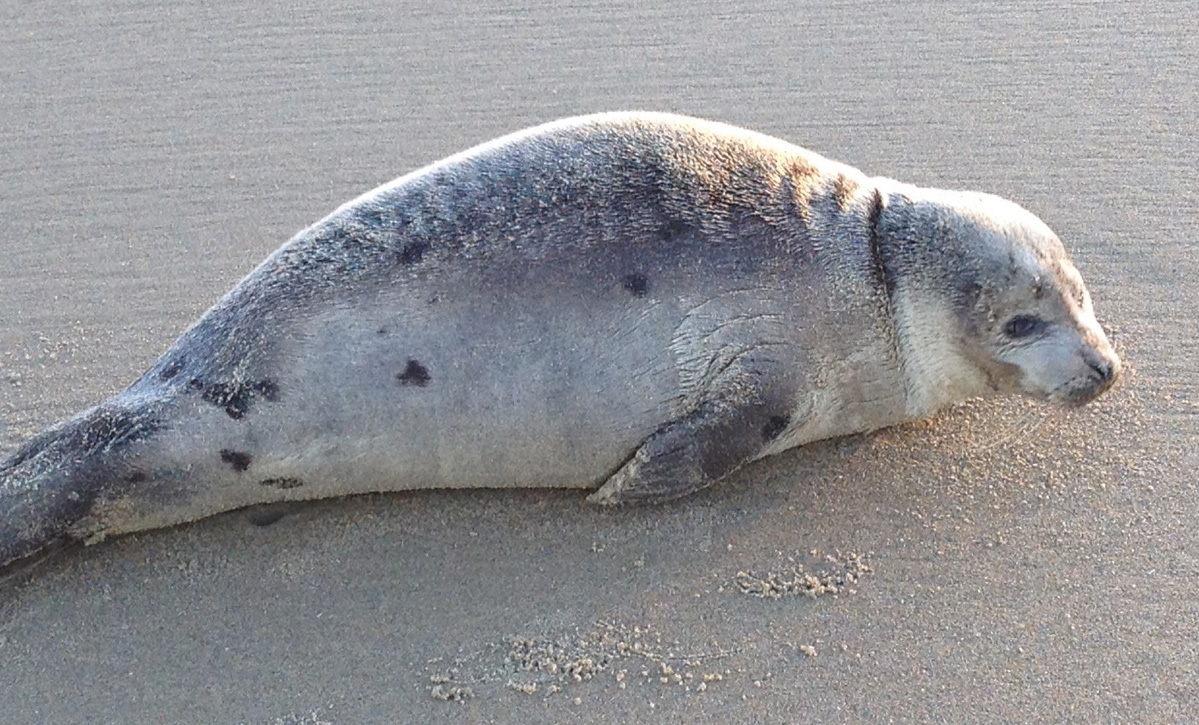 The Marine Mammal Rescue Team responded to their first harp seal (Pagophilus groenlandicus) of the year on February 16th. The seal was sighted on a beach near the Seabrook/Salisbury line. Despite sub zero temperatures, harsh winds, and ten-foot snowdrifts, field volunteers were able to get on the beach to locate the seal. The juvenile was in good condition, but appeared slightly dehydrated and had a swollen muzzle. MMRT will monitor the beach and re-assess the seal if it has not returned to the ocean and determine if rescue is required.
The Marine Mammal Rescue Team responded to their first harp seal (Pagophilus groenlandicus) of the year on February 16th. The seal was sighted on a beach near the Seabrook/Salisbury line. Despite sub zero temperatures, harsh winds, and ten-foot snowdrifts, field volunteers were able to get on the beach to locate the seal. The juvenile was in good condition, but appeared slightly dehydrated and had a swollen muzzle. MMRT will monitor the beach and re-assess the seal if it has not returned to the ocean and determine if rescue is required.
Harp seals are typically only seen in New Hampshire during the winter. They are winter visitors to our coast, swimming down from the Arctic to visit and forage for food before returning north to the Canadian provinces. Adults are easily identified by the dark harp-like shape on their coats and are approximately 5-6 feet long and weight around 300 pounds. Females give birth from late February through March.
February 1, 2015
20K Challenge Gift to Save the Seals!
On an average year, it costs $70,000 to keep our Marine Mammal Rescue Team ready to respond. This year, your contribution will go twice as far thanks to a challenge match.
New Castle residents, Cyrus and Bobbie Sweet, understand the need for community support to help sustain the rescue effort, and have issued this challenge: they will match ever dollar given this year up to $20,000!
All marine mammals are protected by the Marine Mammal Protection Act, which was enacted by the federal government in 1972. Although federally mandated, funding to support the work being done by National Marine Fisheries Stranding Network members has been drastically reduced. Of the 100 Network members, it is anticipated that only twelve organizations will receive support from the Prescott Rescue Assistance Grant this year.
“While other areas of the Center’s operations are funded, in part, by fee for services, this is not the case with our Marine Mammal Rescue program. The seals cannot pay,” said SSC President Wendy Lull. “That is why we rely on community support. The Sweet’s challenge gift not only doubles the value of every dollar you donate, it also helps us build a permanent base of community support.”
The Center's Marine Mammal Rescue Team staffs a 24/7 hotline (603-997-9448) and deploys first responders along New Hampshire’s 238 miles of coast, which includes the Great Bay estuary and White and Seavey Islands.
During 2014, the Center’s Team responded to 72 seals (58 harbor seals, 4 grey seals, 3 harp seals, 1 hooded seal, 6 unknown), and 1 harbor porpoise. Ten animals where rescued by moving them away from danger to quiet beaches or transporting them to regional rehabilitation facilities.
Lull notes, “Our rescue and response efforts help keep the animals and the public safe, but that is not all. Marine mammals serve as an early warning system for ocean health. The data we collect, along with other Network members, is an important piece of ecology research on the national level.”
You can make your tax-deductible donation a here.
January 31, 2015
Kennedy's Release!
After 3 1/2 months of rehabilitation, Kennedy was released back into the wild as a large crowd of her fans watched on. We wish you a long and happy, healthy life in the big blue Kennedy!
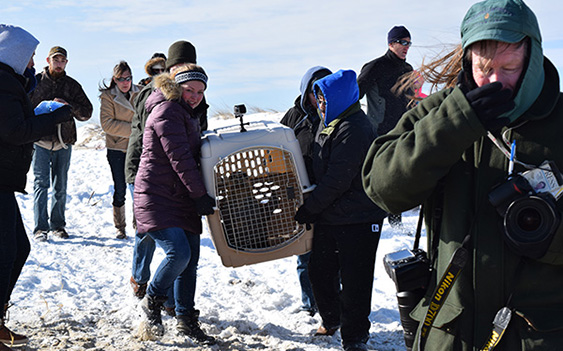 |
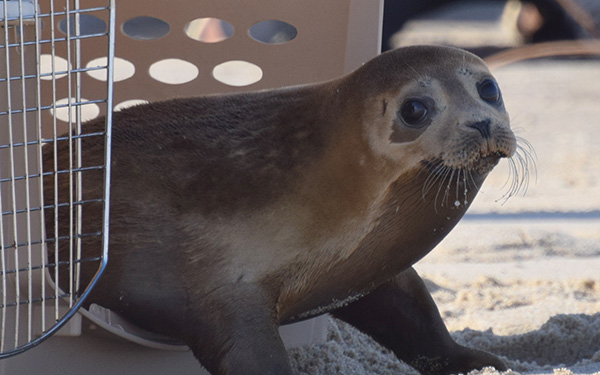 |
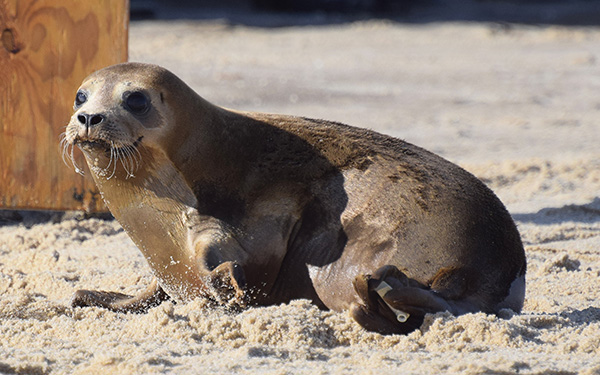 |
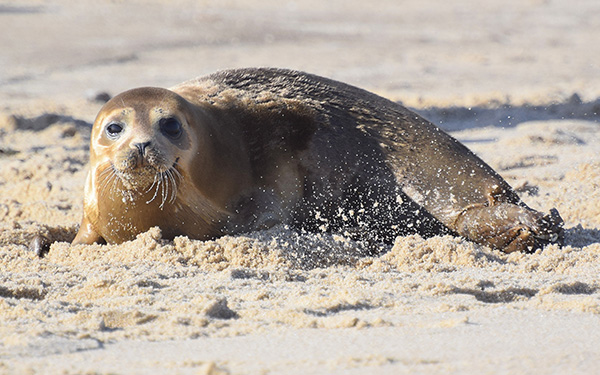 |
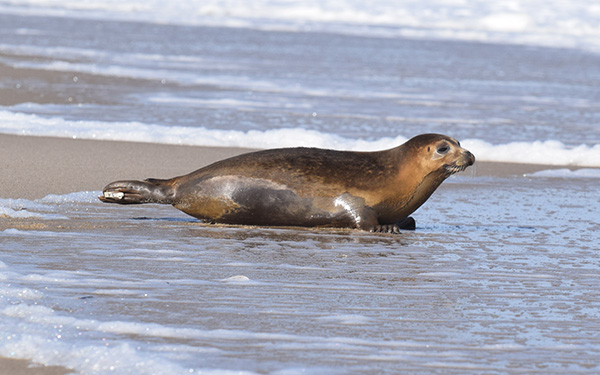 |
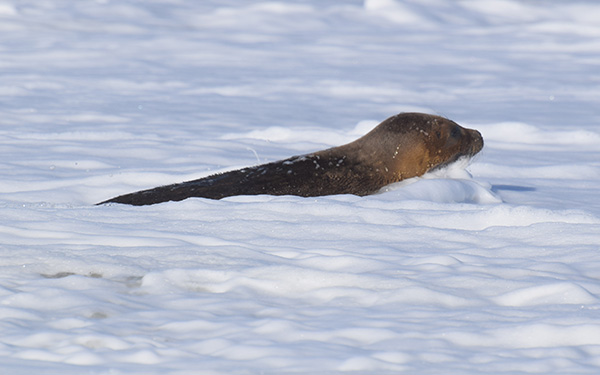 |
January 6, 2015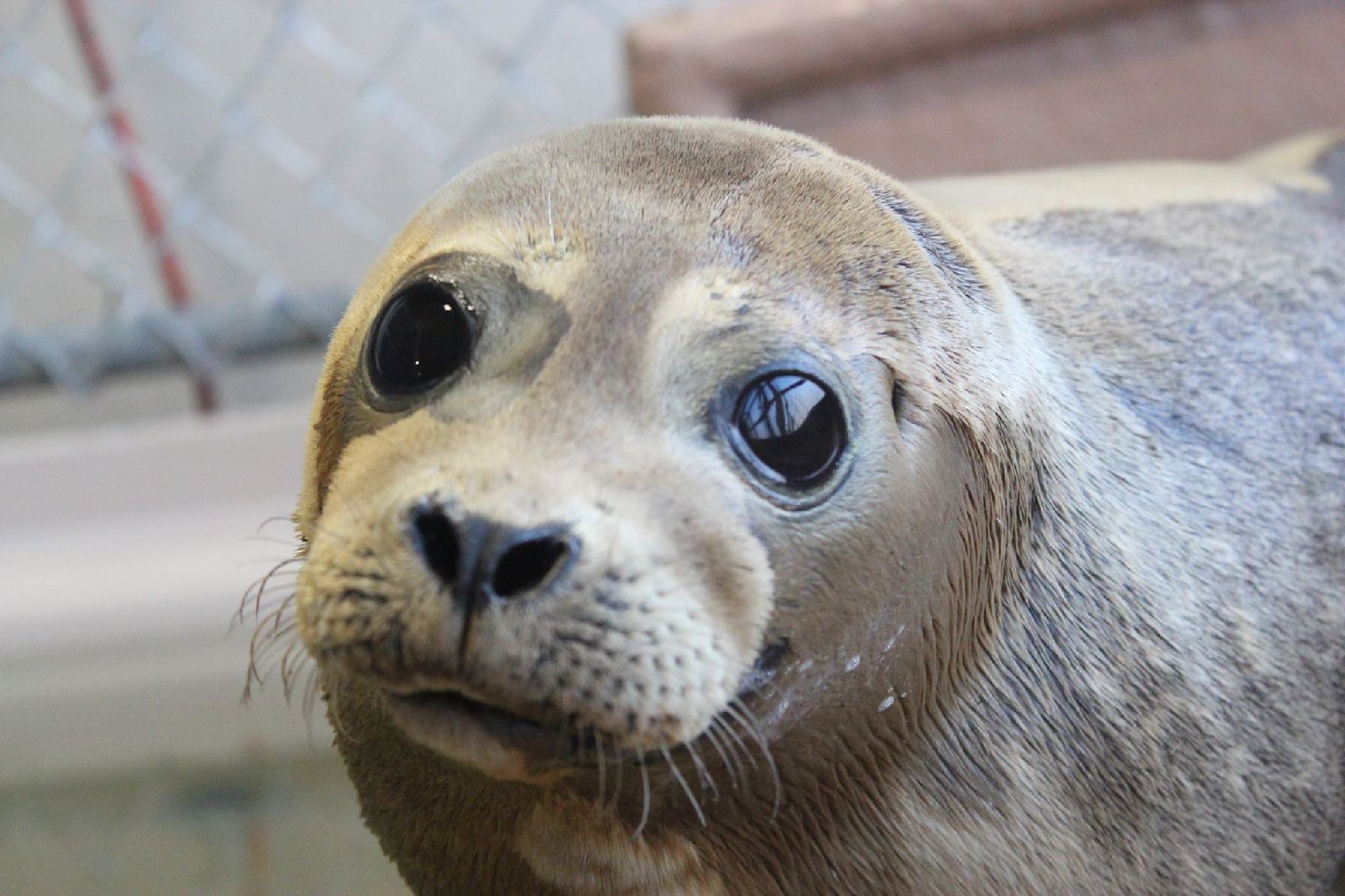
Update on Kennedy
Kennedy, the female weanling harbor seal rescued on Straws Point Beach in Rye, NH on October 14, has made great improvements! National Maine Life Center's Dr. Williams' recent examination found that her broken jaw and facial wounds have healed! She has recovered from pneumonia, is gaining weight, and is eating on her own. If she continues to improve, she will be ready to release mid January. Stay tuned!! (photo by NMLC)
January 1, 2015
MMR 2014 Year in Review
The Seacoast Science Center launched New Hampshire's first Marine Mammal Rescue Program on January 1, 2014 and has been granted it's three-year Stranding Agreement from National Marine Fisheries Service. Click on the document image below for highlights of the MMR's inaugural year. A full report can be found here.
.jpg) |
.jpg) |

